[Alternative title: Environmental Sustainability in the Western US + some really pretty photos and tourist information]
This summer I travelled to the United States for the first time, and embarked on a road trip which looked something like this:
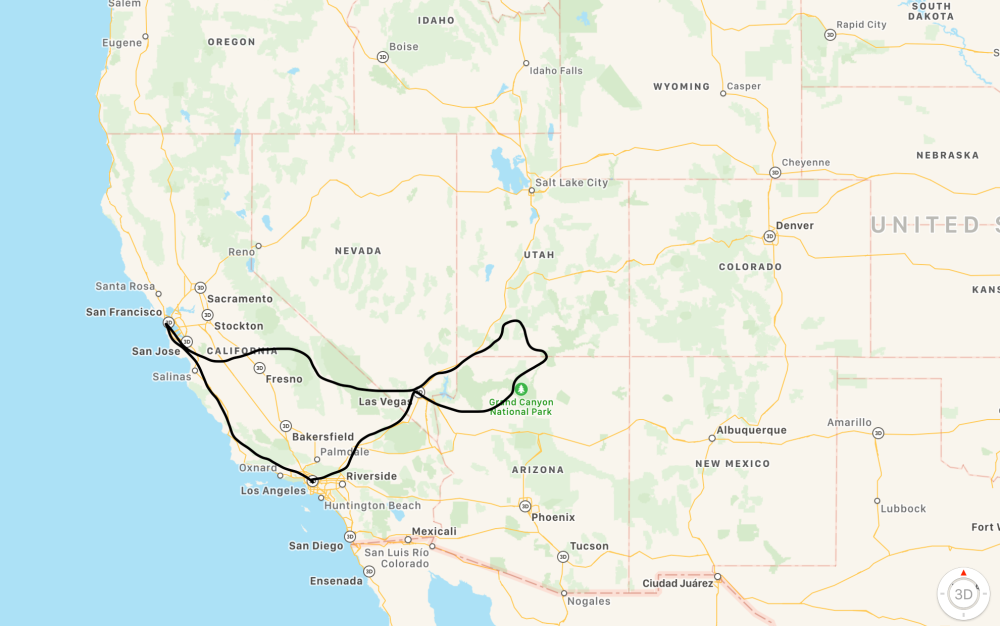
Flying to Los Angeles, we spent a few days travelling along the west coast up to San Francisco, proceeding then further inland through Palo Alto and the extent of Silicon Valley. Venturing as far as Utah, we planned stops in beautiful national parks. Yosemite to Death Valley, then onto Zion and Bryce and finally the Grand Canyon. Despite seeing so many places, our visits were mere glimpses into these diverse environments, as we did all of this in two weeks.
As you may know, environmentalism is extremely important to me. In my opinion, our future, including the possibility of resolving problems such as hunger, obesity, epidemics, and extreme weather, rests largely with how we treat our ecosystems. I have talked about the importance of protecting our planet in these posts before, in the process highlighting our needs as an ever-increasing population for enough energy to sustain our growing cities and lifestyles. I talked about the potential we have to harness a continual source of energy that we may use to support our way of life without overwhelming the planet.
Before I came to the United States, a country which uses 24% of the world’s energy for just 5% of the population, I was led to believe that the vast consumption culture would greatly dwarf any sustainability measures taken. Instead, the reality pleasantly surprised me, and I’ve decided to dedicate my own documentation of our trip to the efforts that I saw. I wanted to see how much small businesses, corporations, federal agencies and locals were doing in order to be sustainable. With the recent ‘advice’ administered by the Trump Administration to ‘avoid’ using the phrase ‘Climate Change’, it is more urgent than ever for us to not forget the most vital and pressing issue which affects us all.
From the tiny glimpse that I saw in the relatively minuscule time bracket that I was there for, retrospectively, I was deeply impressed. The places I went to and saw were giving me constant reminders to consciously take efforts to do my bit to protect the environment. Whether that was to throw away plastics into a conveniently placed recycling basket, take reusable bags to the store or time my showers to be no more than 5 minutes long (apparently 60% of people have an average shower time longer than this), there were signs and placards everywhere.
In some areas such as San Francisco, the emphasis was placed on water security and plastic waste, whereas in the National Parks, air quality, visibility and ecosystem protection were very high priority. Chronologically, I will be showing you these endeavours as I saw them. Some areas, like Los Angeles, I do not have any photos for, which is not to say they didn’t have a progressive attitude towards being environmentally friendly. In these cases, I will give you a general overview of sustainability in that area. Also general (i.e stunning) photos are to follow.
Los Angeles CA
Los Angeles was our first and last destination, and one can not talk about their eco-friendly endeavours without mentioning the gigantic Sustainability City pLAn. The goal with this is to turn Los Angeles into an egalitarian and economically sustainable city within the next 20 years. The pLAn was introduced by the mayor, Eric Garcetti, in 2015 and is composed of short-term (until 2017) and long-term (2025-2035) goals. They have several environmental goals, including one to reduce average per capita potable water use by 20%, a goal they have already met way ahead of schedule, and especially important to a city heavily affected by drought. This entire project is very transparent, with their progress updated regularly on the website. It is well worth a read as the individual sections detail tackling water waste, using solar energy, and protecting the urban ecosystem with incredible detail.
What I enjoyed the most, is that this plan operates on a grand scale. It is very much an official initiative, pulling out all the stops to transform LA on a wide scale. This, combined with any small, personal initiatives by locals could combine to make a big difference.

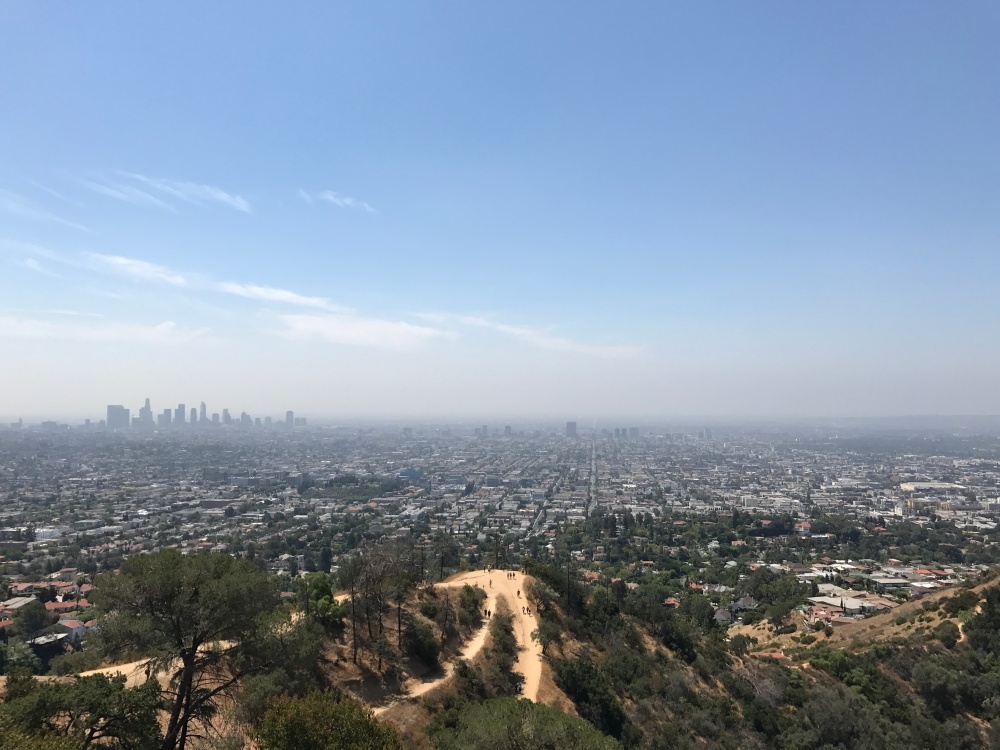
A layer of smog blanketing Los Angeles and the Downtown area can be seen from Griffith Observatory.
San Francisco CA
San Fran was incredible. I was overwhelmingly impressed with the city, and the general sustainability vibe I got from the hotel we stayed at, the Marriott Marquis. The hotel has recently been honoured by the City of San Francisco and Recology for recycling and composting 85% of its waste – subsequently achieving one of the highest resource recovery rates among hotels in the United States. The Marriott has collaborated with Toolworks, a nonprofit facility which helps find and provides jobs to people with disabilities, in order to achieve this.
The San Francisco Department of the Environment is primarily responsible for pioneering action towards making the city more eco-friendly and sustainable. SFEnvironment recently released their 2016-2020 Strategic Plan, a ‘living’ manifesto which gets updated constantly and outlines the environmental plans and strategies which will be put into effect in the next couple of years. San Francisco is regarded as ‘one of the cleanest cities in North America’, and SFEnvironment is keen to uphold that, with plans for Zero Waste, clean energy and transport, and sustainable buildings either in effect or proposed for the future.
Something else which I noticed was the abundance of water bottle filling stations. This is not unique to San Francisco, as you will see later in the post, but the city is unique in that it recently banned the sale of all single-use plastic bottles. The problem is that these bottles often end up in landfill sites and in the sea, and the ocean-front city has recognised that this is a major problem in the way of their Zero Waste initiative. In the hotel where I stayed, water filling stations (many of which also dispense ice) were located on every floor of the hotel, including the lobby, complete with an ever-increasing digital count of how many water bottles have been saved from the landfill. In the room where one would expect to find a bottle of water was instead a sign, directing the guest of the room to the nearest water filling point.
Yosemite National Park CA
Our first national park, Yosemite, was breathtaking.
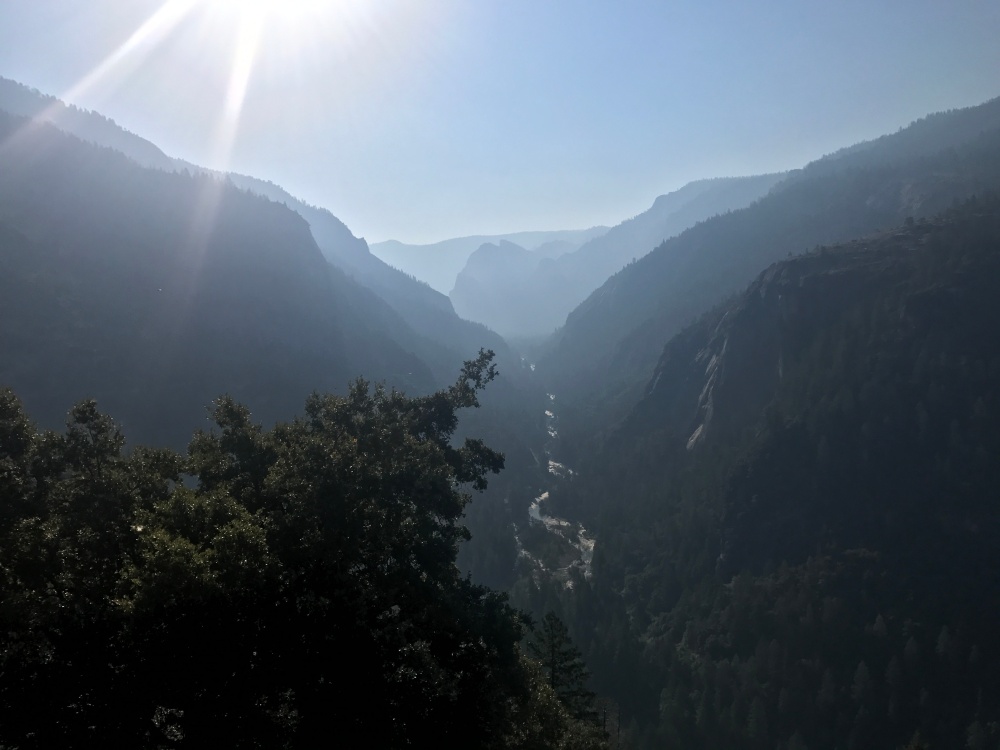
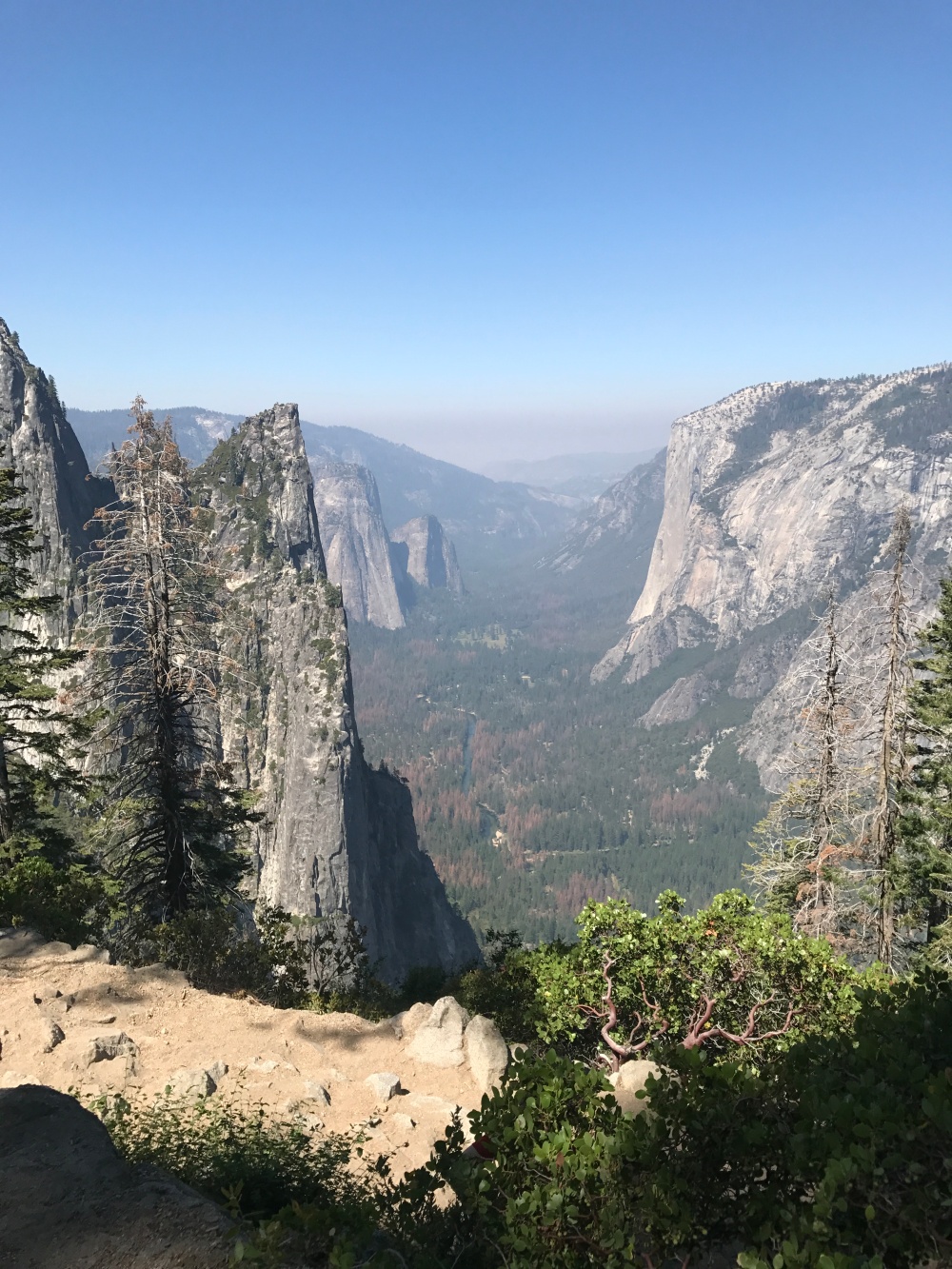

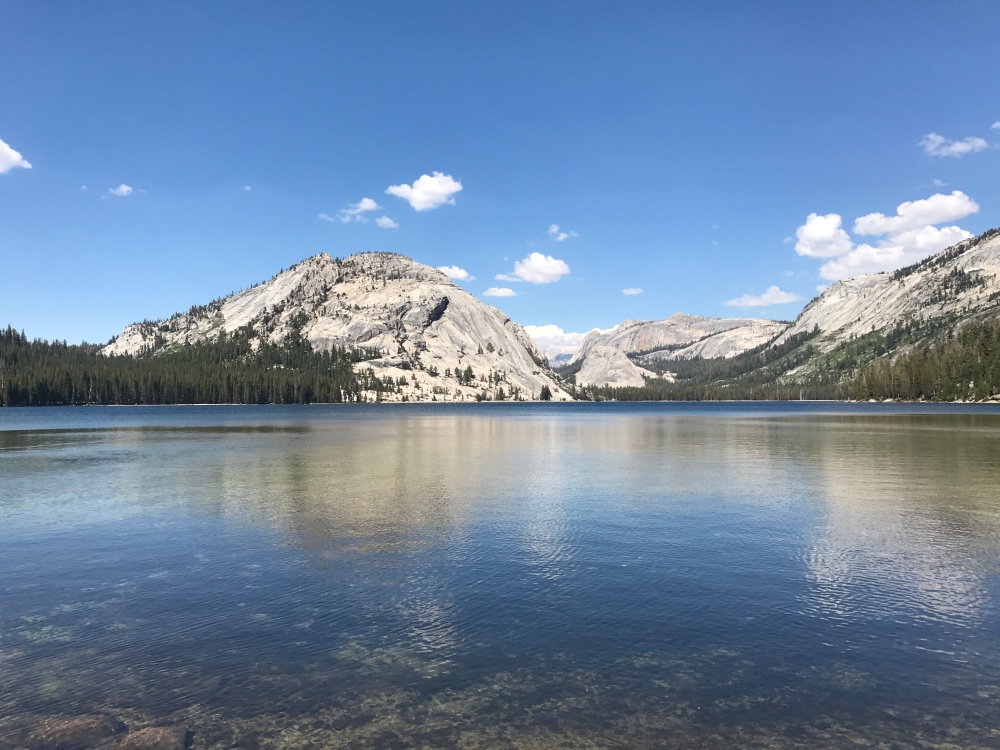
There were certain rules you had to follow, for example not venturing off the track and not starting fires. Some of these rules are put in place for personal safety – the park is home to bears and mountain lions, as well as crevices, sharp drops and falling rocks. They also aided conservation efforts, the less human contact in a place the less likely it is to degrade. Wild fires are also common in areas of Yosemite, Stanislaus and the Sierra Nevada, with the drought season heightening the risk of uncontrollable fires sweeping out the woodland. They are a lot more common than I originally thought, with the California Department of Forestry and Fire Protection reporting a running total of 4,625 fires in 2017 alone, burning through over 1,200 square kilometres. Because of this, parks like Yosemite prohibit human-made campfires or even establishing controlled wildfires of any kind, with appropriate prosecution for violating these laws.
Death Valley
It’s hot.
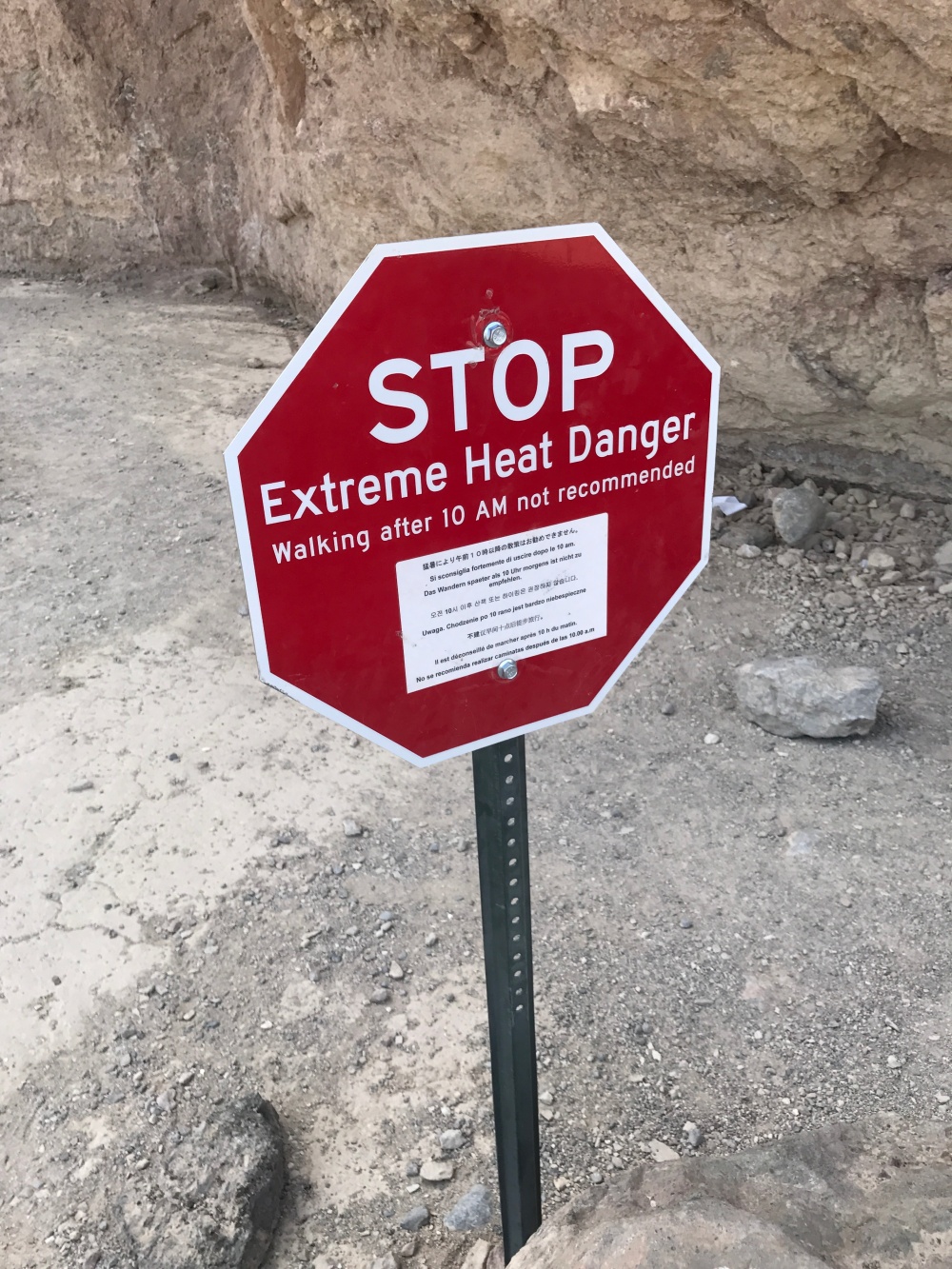
Reaching 46 Celsius during the day and containing the lowest point of elevation in North America (Badwater Basin), Death Valley is notorious for its hot winds (even at night), basically no rainfall, deathly silence, pretty stars and renowned isolation. It is a desert valley, and during the high summer months, i.e precisely the time we went, it is the hottest place on Earth, along with some deserts in Africa and the Middle East. Going there was one of the most interesting experiences I have ever had. We stayed at Furnace Creek, a ‘village’ with an actual population – 24 people. Furnace Creek holds the record for the highest ever temperature recorded on the surface of the planet, 57 Celsius (134 F) on July 10th 1913. From the late evening to noon that we were there, the temperature did not dip below 38-40 degrees. If not for the air conditioning it would have probably been almost unbearable.
Everywhere there were signs like this one, warning of the dangers of dehydration. Indeed in summer, a person can lose a quart of body moisture an hour while at rest, the risk of fatality is high, thus the park has to take precautions.
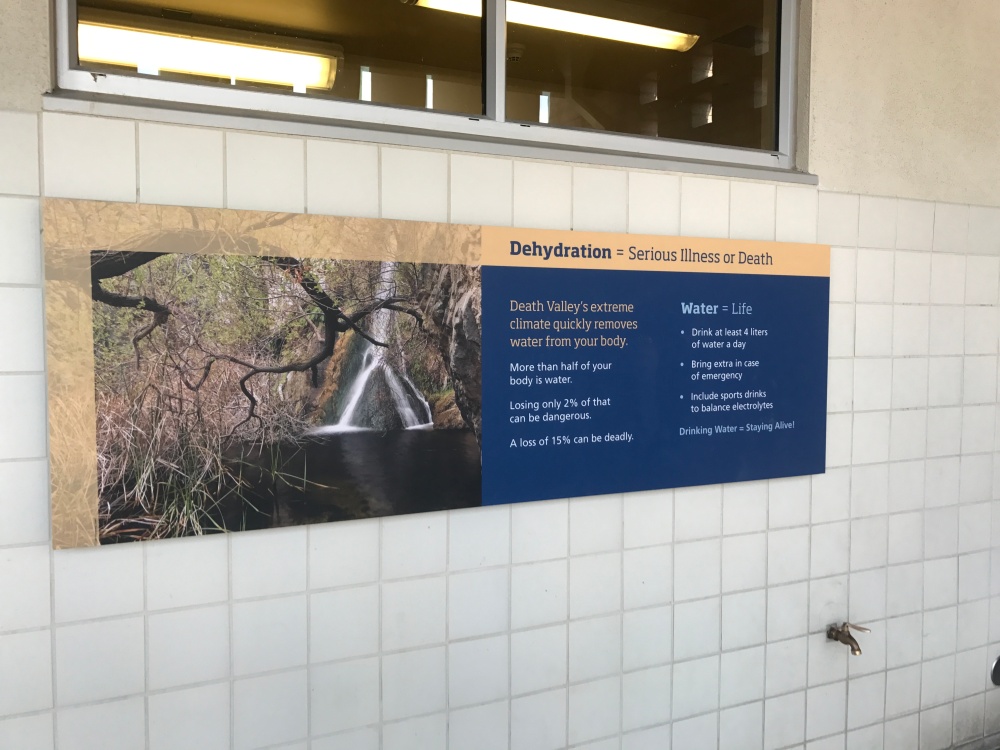
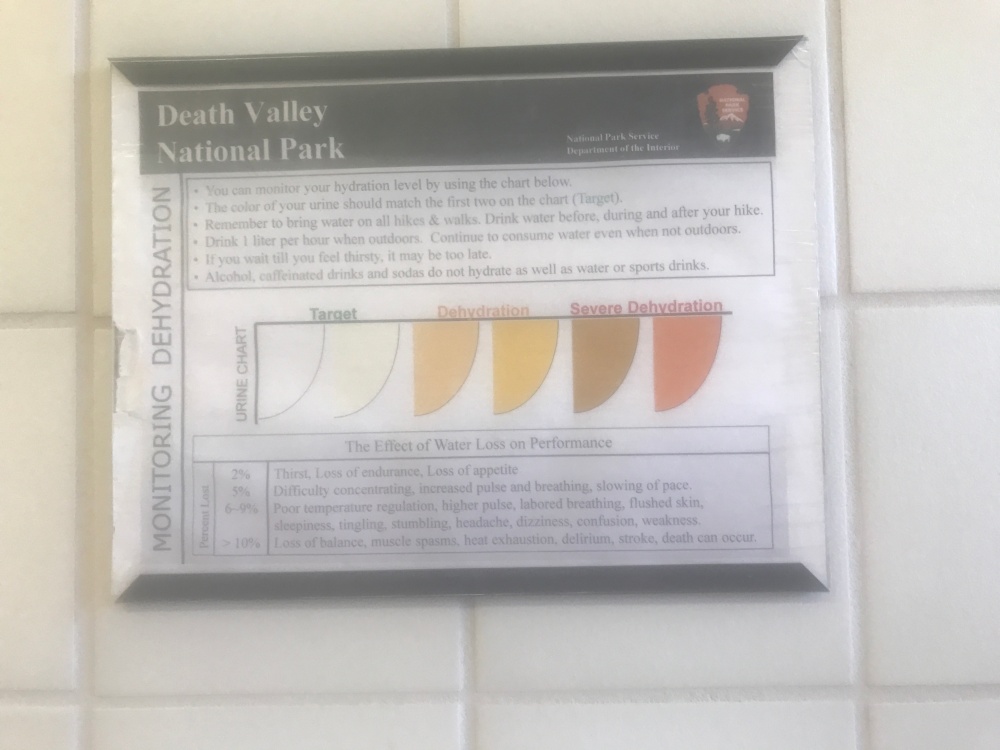
Furnace Creek Ranch, a popular resort hotel located centrally within the park recognises that water is a scarce resource, and takes various measures to involve its guest in the process of conserving it. For example, in the bathrooms of every room, there are signs asking you to limit the amount of water you use, to reuse your towels (common to most of the hotels we stayed at, actually), and explaining why single-use bottles for shampoo/shower gel/conditioner are not provided. There is a separate recycling bin in every room, and the hotel’s sustainability ethos is outlined in the guest guide.
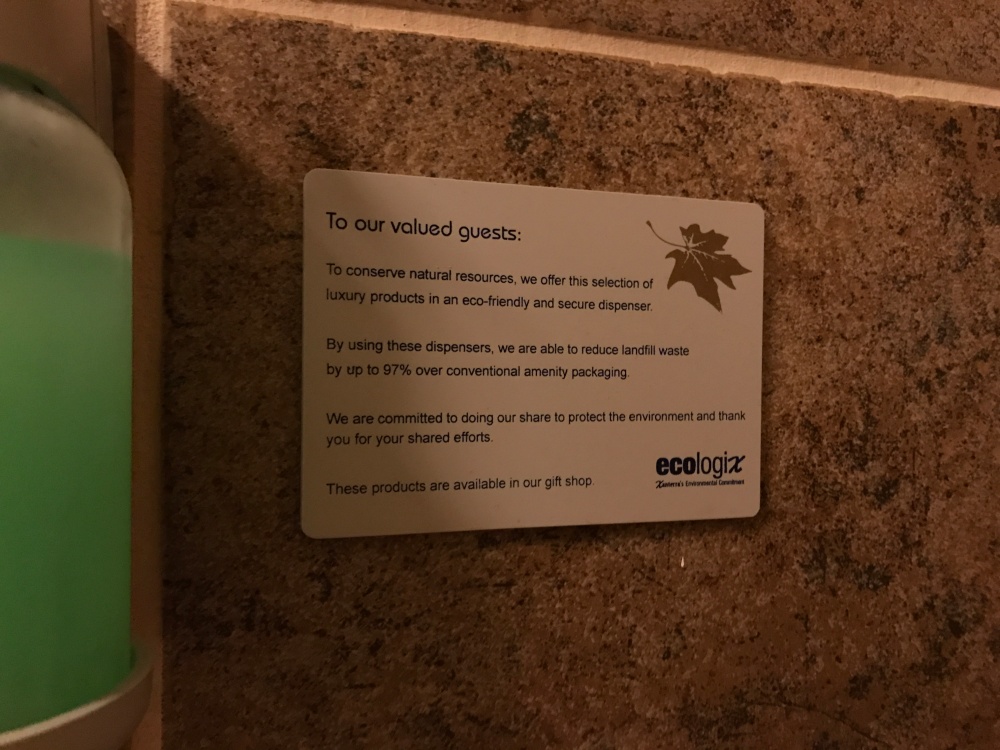
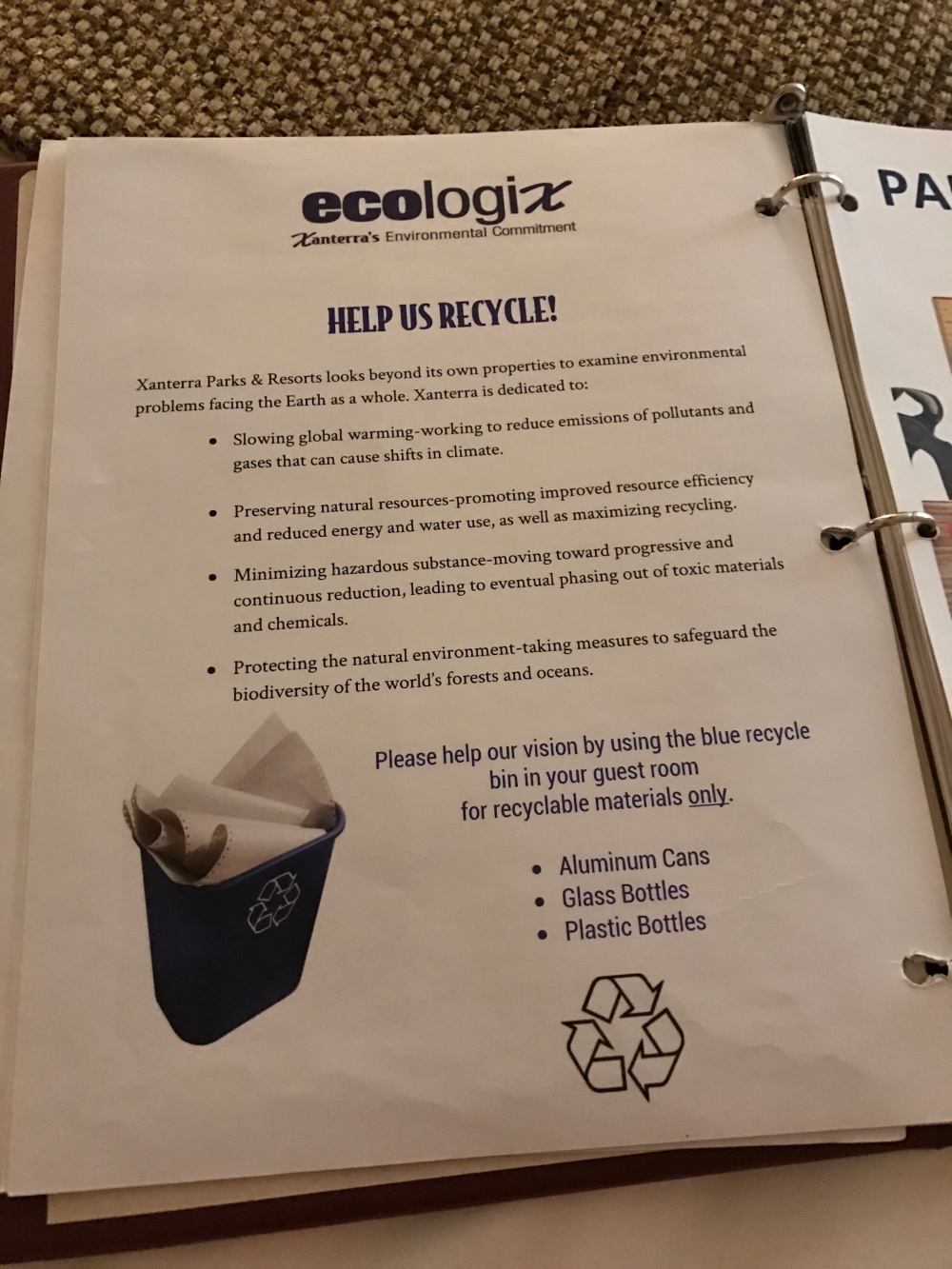
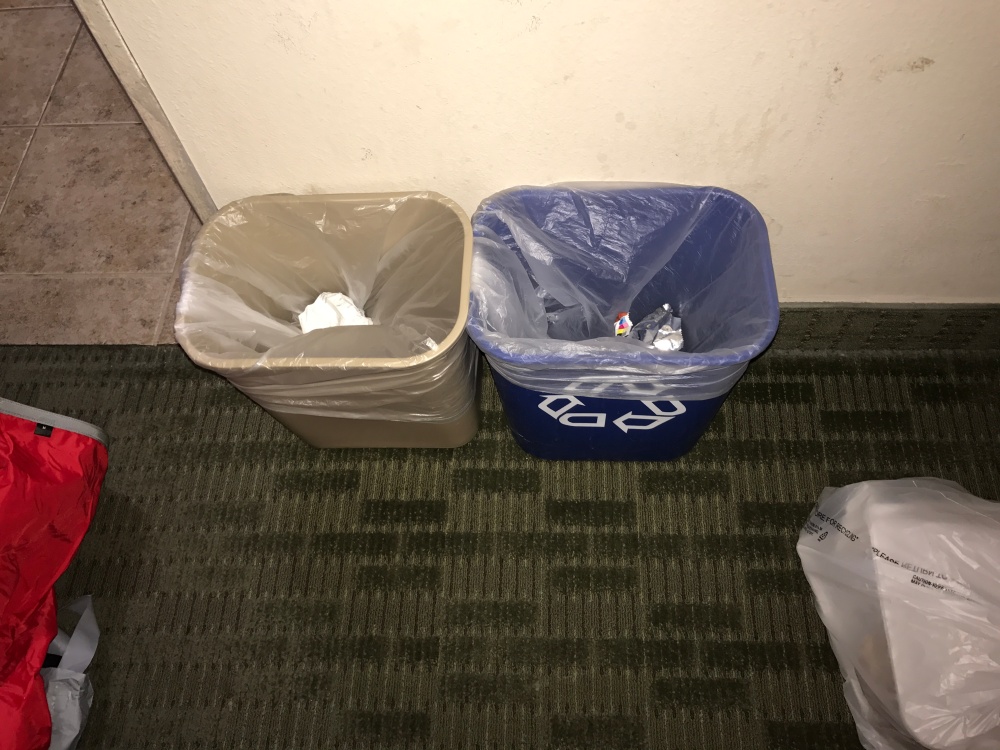
Death Valley is an outstanding geological example of a basin and range configuration. It’s unique topology gives it the oven-like heat which does not drop at all over night. This is unlike typical deserts like the Sahara, where the temperature can dip to below freezing over night. Death Valley was beautiful in its peculiarity. The landscape looks like something from another planet, and indeed scenes from Star Wars A New Hope and Return of the Jedi were filmed there:
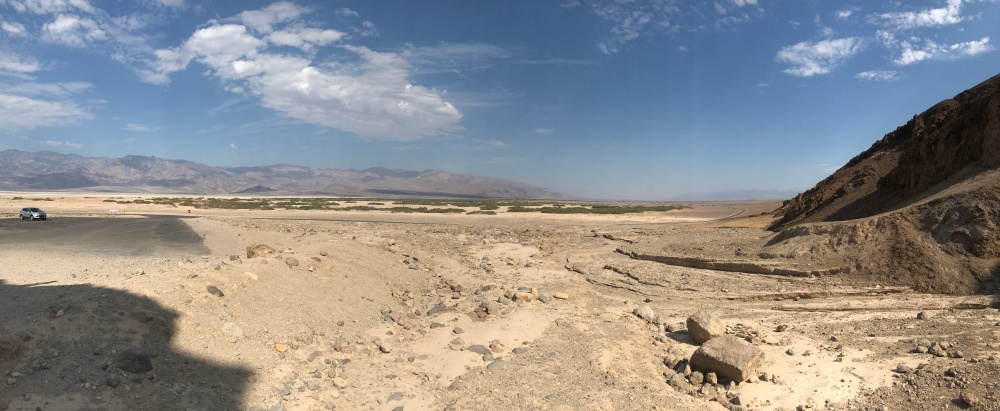
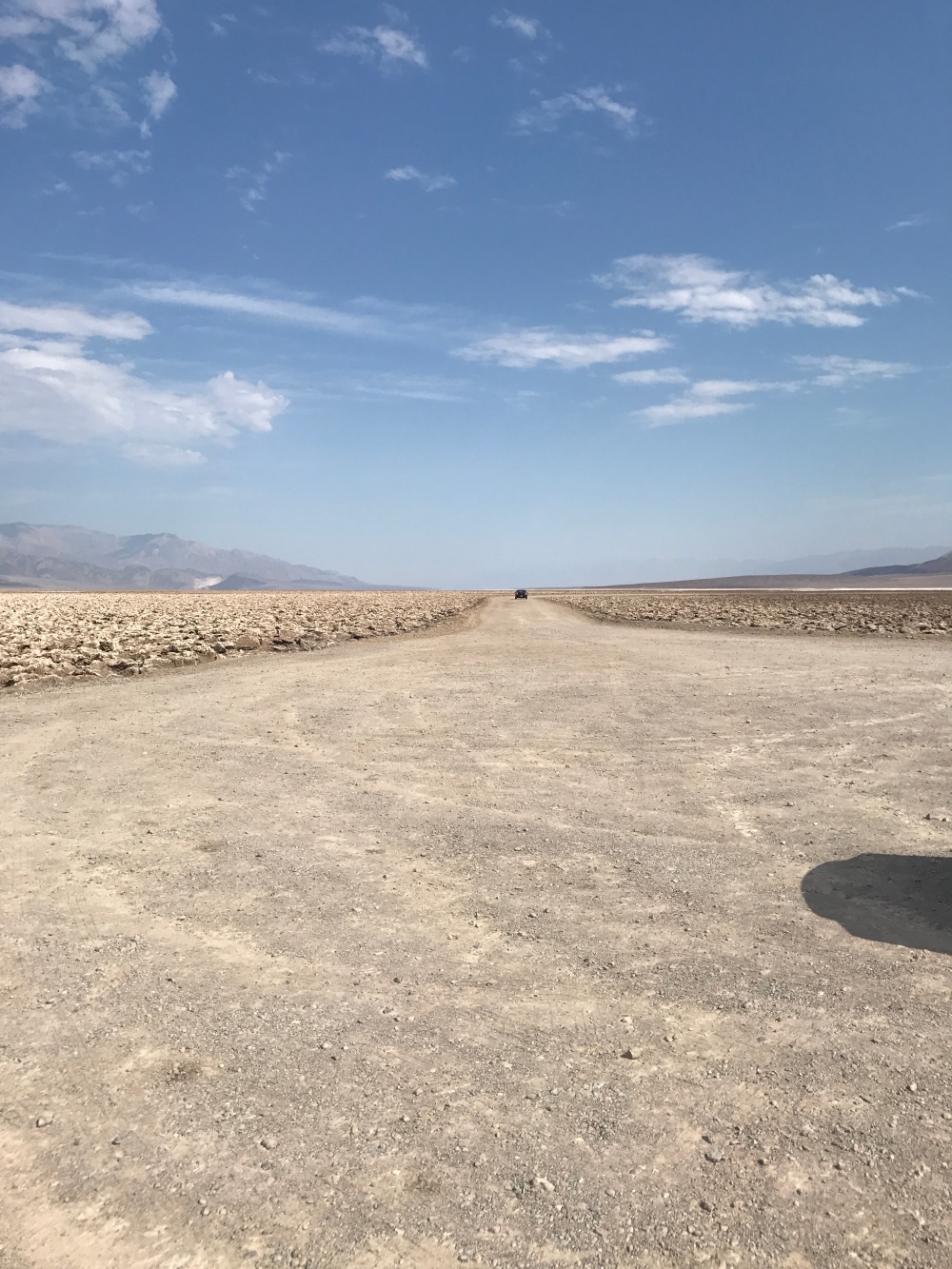



Although Death Valley is a hot, dry desert, it is subject to some of the most extreme weather in the world. Flash floods, violent thunderstorms and severe droughts are common in the area during certain seasons, and they have been accelerating in frequency due to climate change. Cue Congress fainting. Flash flooding is common in a valley and can be fatal. Every year people die because their vehicles get swept away by sudden, fast flowing water. Just as we were leaving the bounds of the National Park the National Weather Service sent an alert to all smartphones in the region:

Flash flooding in Death Valley has been known to destroy or close thousands of kilometres of road and infrastructure, making some locations more remote, and escape and rescue missions harder. Notably, in October 2015 a flash flood with a maximum flow estimated at 3,200 cubic feet per second, the largest ever since the 1920s and depositing debris over 10 feet high, destroyed Scotty’s Castle – a land mark and favourable tourist attraction within Death Valley. The damage to infrastructure, utilities and the surrounding landscape was so severe that Scotty’s Castle has been temporarily closed, and the repair projects are very large and complex, so the target time for reopening the landmark is as late as 2019.
The fact that this is the most intense and damaging flash flood the park has seen in a long time is upsetting, it only highlights more intensely the delicacy and brutality of nature, and our unimaginably steep impact on it. We can not go on pretending that our actions are without effect. Multiple reports are finding an increase in cases of extreme weather around the world – not just in the western US. However, their effects are being felt in the most vulnerable places, such as the isolation of natural beauty in Death Valley.
Overall, the sustainability measures I witnessed in Death Valley were very clear. Particularly at Furnace Creek (one of the rare attempts at civilisation amidst the sweltering heat), they are exceptionally conscious of their carbon and environmental footprint, as they are the first affected by accounts of extreme weather, witnessing its effects first hand. They feel responsible for the resources they have, simply because they are so few; water is conserved, energy is harvested through solar panels, rubbish is recycled.
Basically, in a place where a certain scarcity is evident, more intense measures are taken in order to protect resources. I found this very interesting, as it perhaps suggests that the reasonably limited conservation efforts in other, milder areas may be due to the fact that the consequences of climate extremes are not felt there as much, and that the majority of people do not feel conservation steps are necessary. This is a worrying philosophy, as it shows that we perhaps are not capable of realistically thinking ahead to a future which may not be so bright should we choose to not take any measures to monitor our energy expenditure.
Zion National Park UT
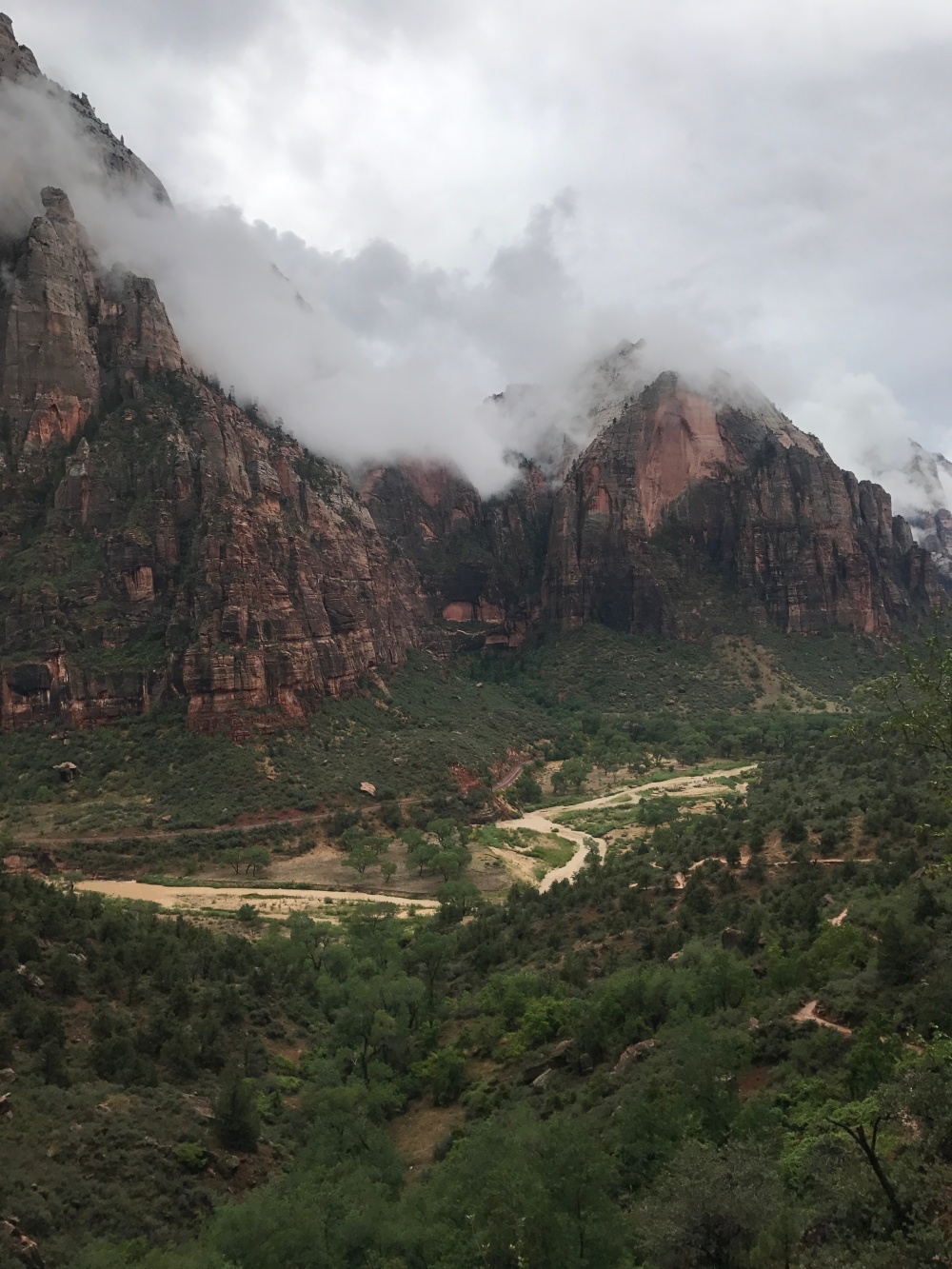
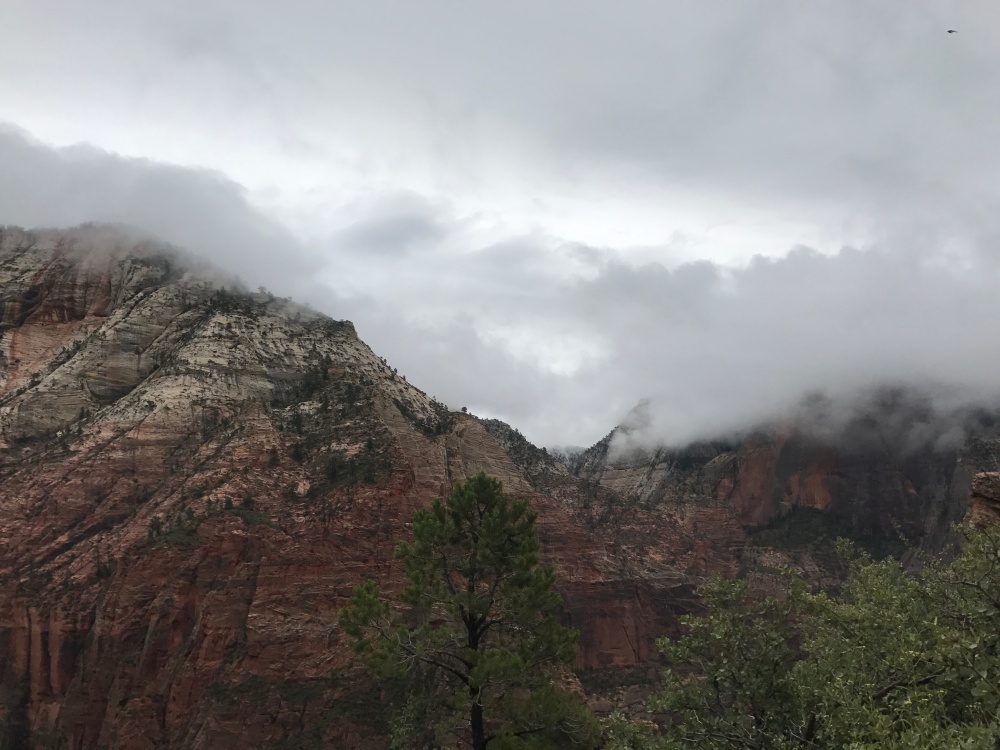
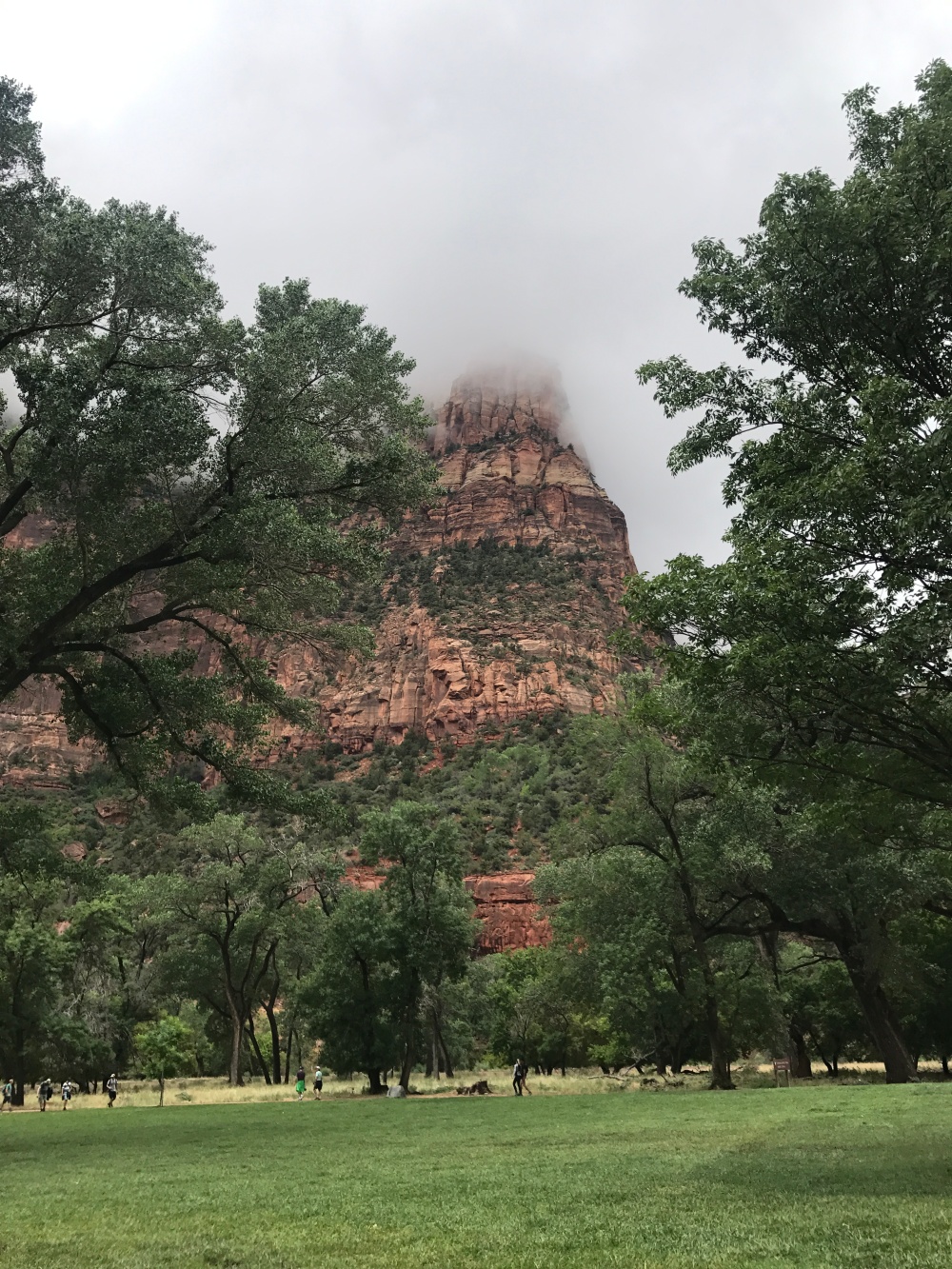


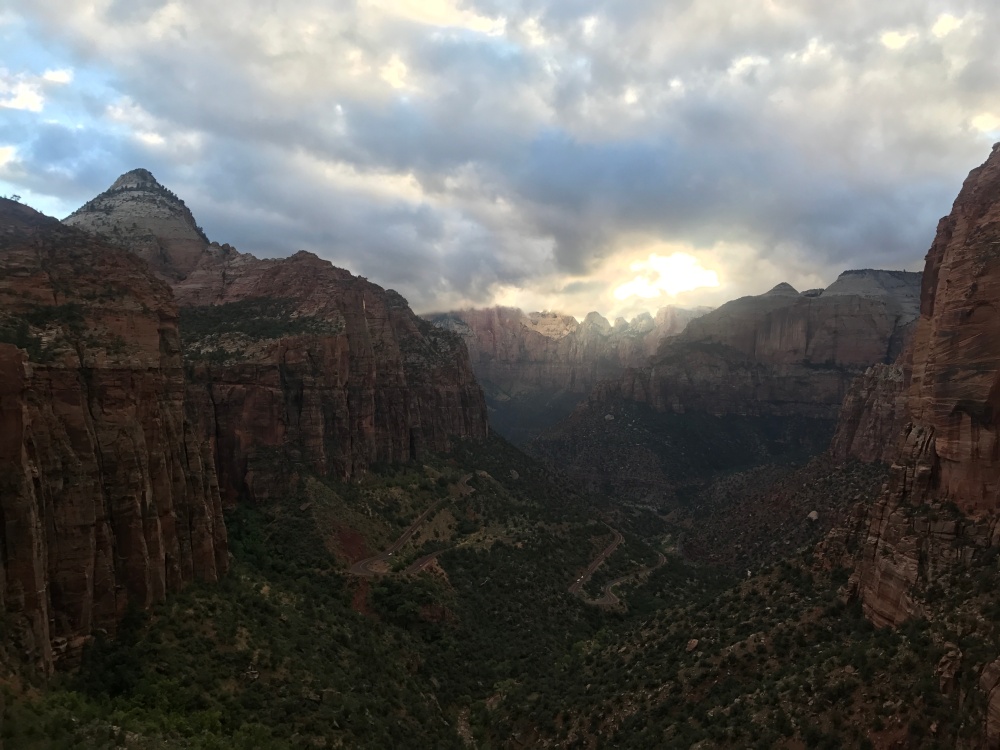
Out of all the parks we visited, I think Zion was my favourite. The palette of colours in the park, the rich red of the rocks and the green in the valleys, was beautiful. The weather was a cool relief from the scorch in Death Valley the day before, and the rainfall combined with the humidity gave it an almost tropical feel.
We took advantage of a delightful amenity within Zion: the free shuttle buses.
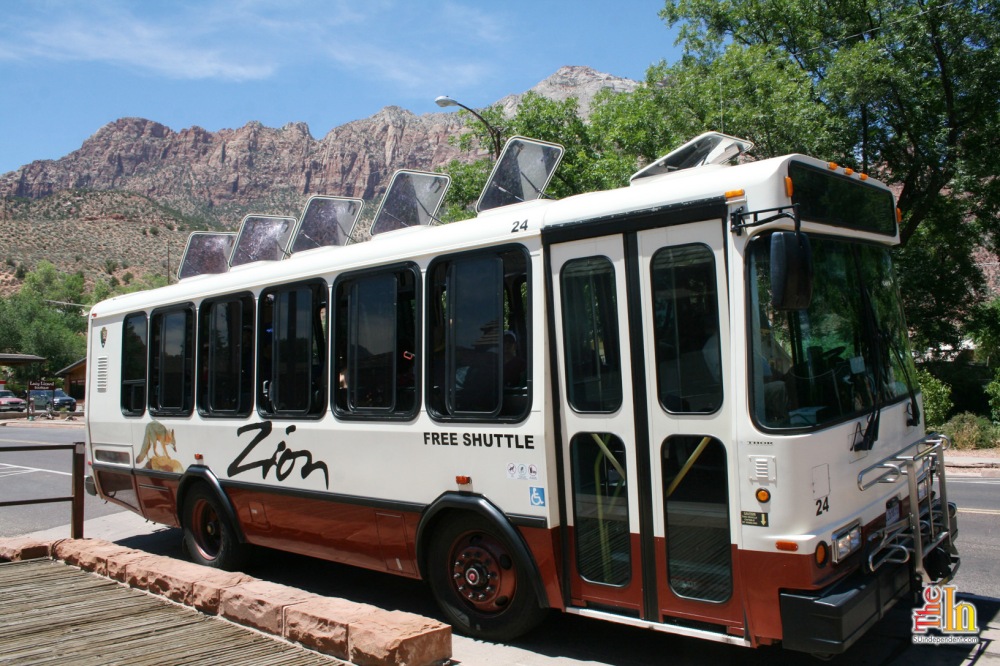
(source)
Zion National park has a fleet of buses which roam the park between 8 different bus stops. They are located at points of interest within the park, and the travel time from end to end is no more than 30 minutes. I was seriously impressed with them, because not only did you usually not have to wait more than 5 minutes for a bus, the majority of the fleet was also composed of hybrid and/or electric vehicles. There were other shuttle bus companies within Zion whose fleets boldly ran entirely on electricity, and indeed since the introduction of electric cars into the park, ten electric charging stations have been implemented with the help of a grant from an initiative from the US Department of Energy. In the near future, Zion’s propane-fuelled fleet will be undergoing an investigation to switch to being fully electric too. Even with the propane-fuelled fleet, the National Park Service claims that each bus replaces 28 visitor cars and reduces CO2 emissions by over 12 tons per day. What more, the shuttles made it extremely easy and enjoyable to get around the park. A pass was not required at all and key information about staying safe, as well as the history and background of the park, was played in an audio book style over the speakers as we drove along. It removed the responsibility and need to have a car in the park, as well as the need to clear woodland to build huge parking lots at every point of interest.
Zion National Park is home to many of the southern US slot canyons, marvellous features of nature where a canyon is carved downwards rather than outwards, forming a coin-slot-like-crevice whose depth is significantly greater than its width. As with other low points, slot canyons are subject to intense flash flooding, so warning signs were displayed everywhere:
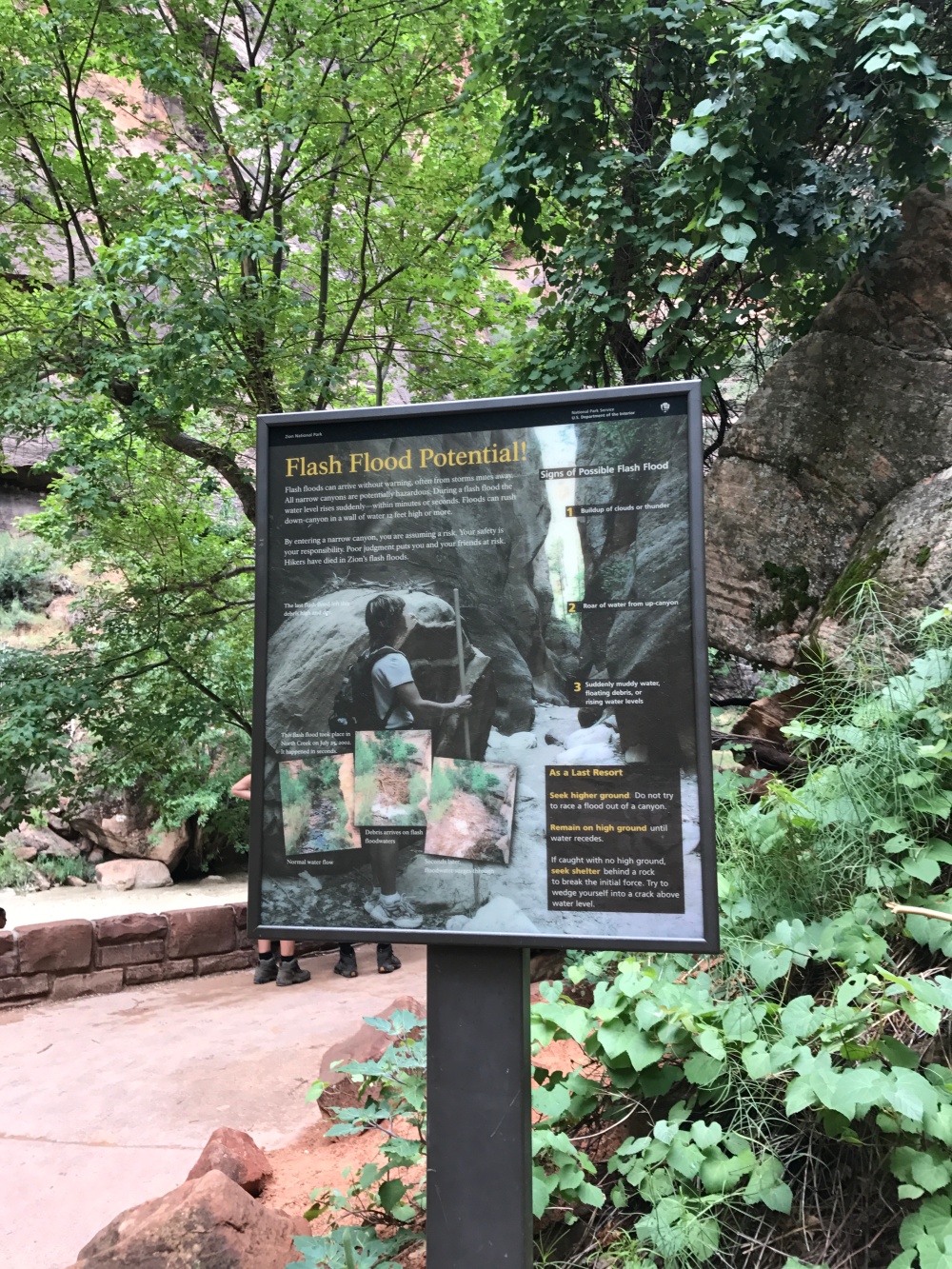
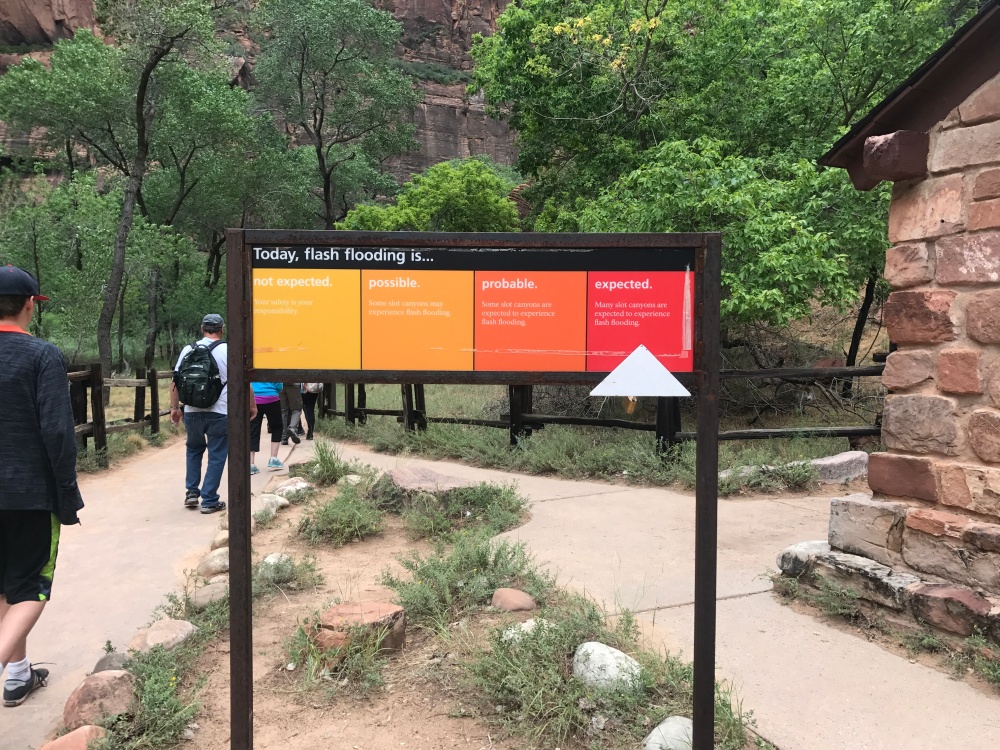
The park was also very cautious about water use, urging us all to think about water conservation by highlighting features within the infrastructure of the park such as toilets and showers which went some way to conserve the precious resource. The park is like Yosemite in the way that it wishes to leave as much of nature as it can untouched. There are signs everywhere recommending one to stay on the path (usually clay or tarmac) and enjoy the scenery from there.
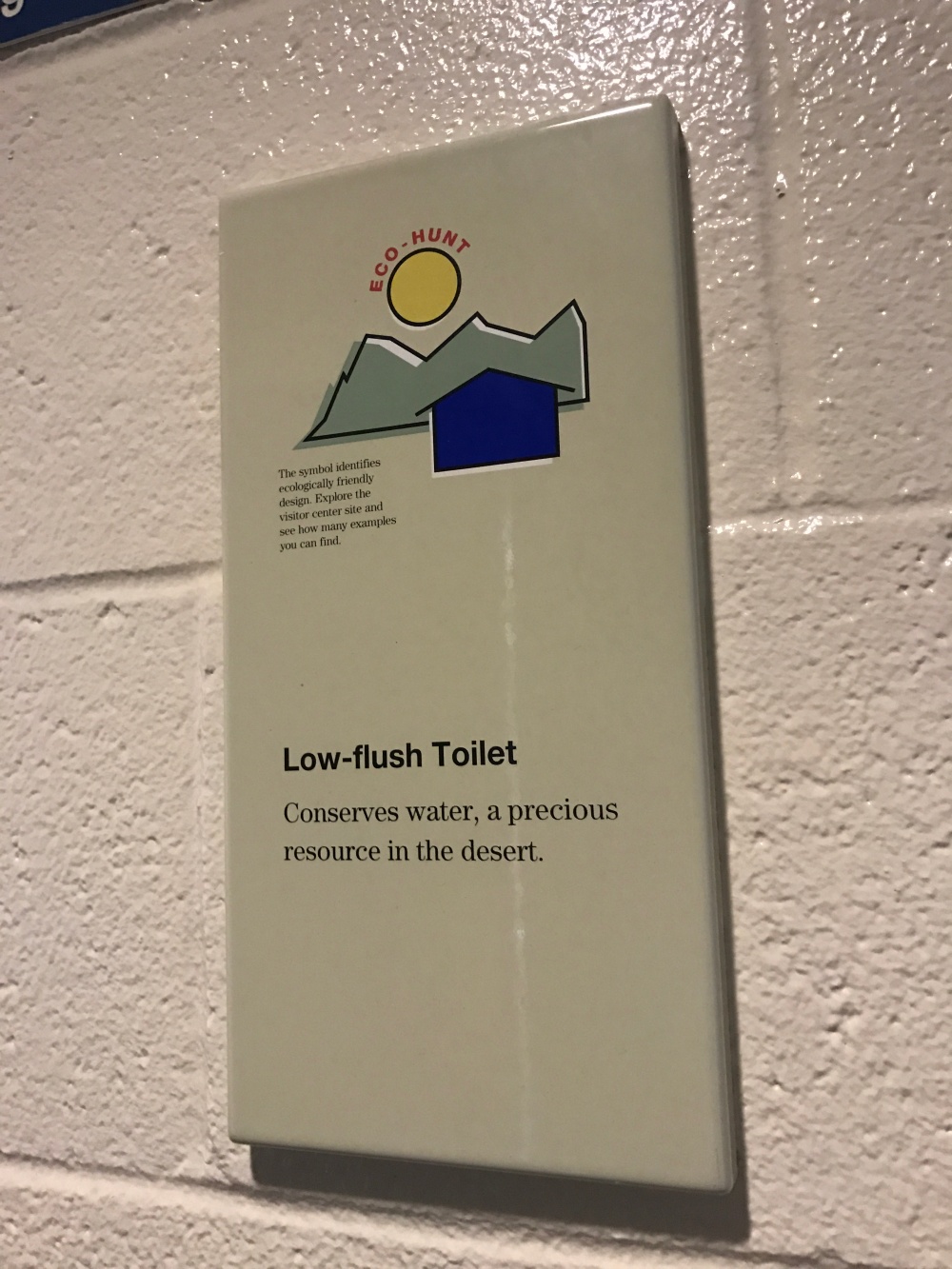

I apologise profusely for my extraordinary ability in the visual arts, as evident from the clarity of this photo.
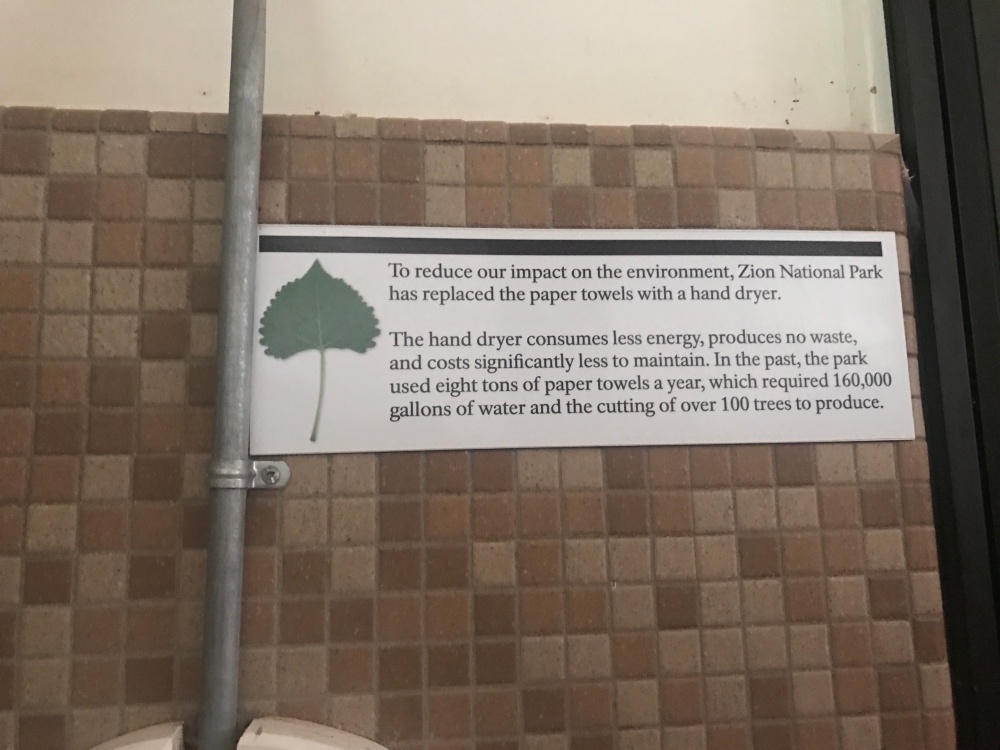

The hotel we stayed at was also environmentally sensitive, again gently yet directly reminding the guest to conserve resources.
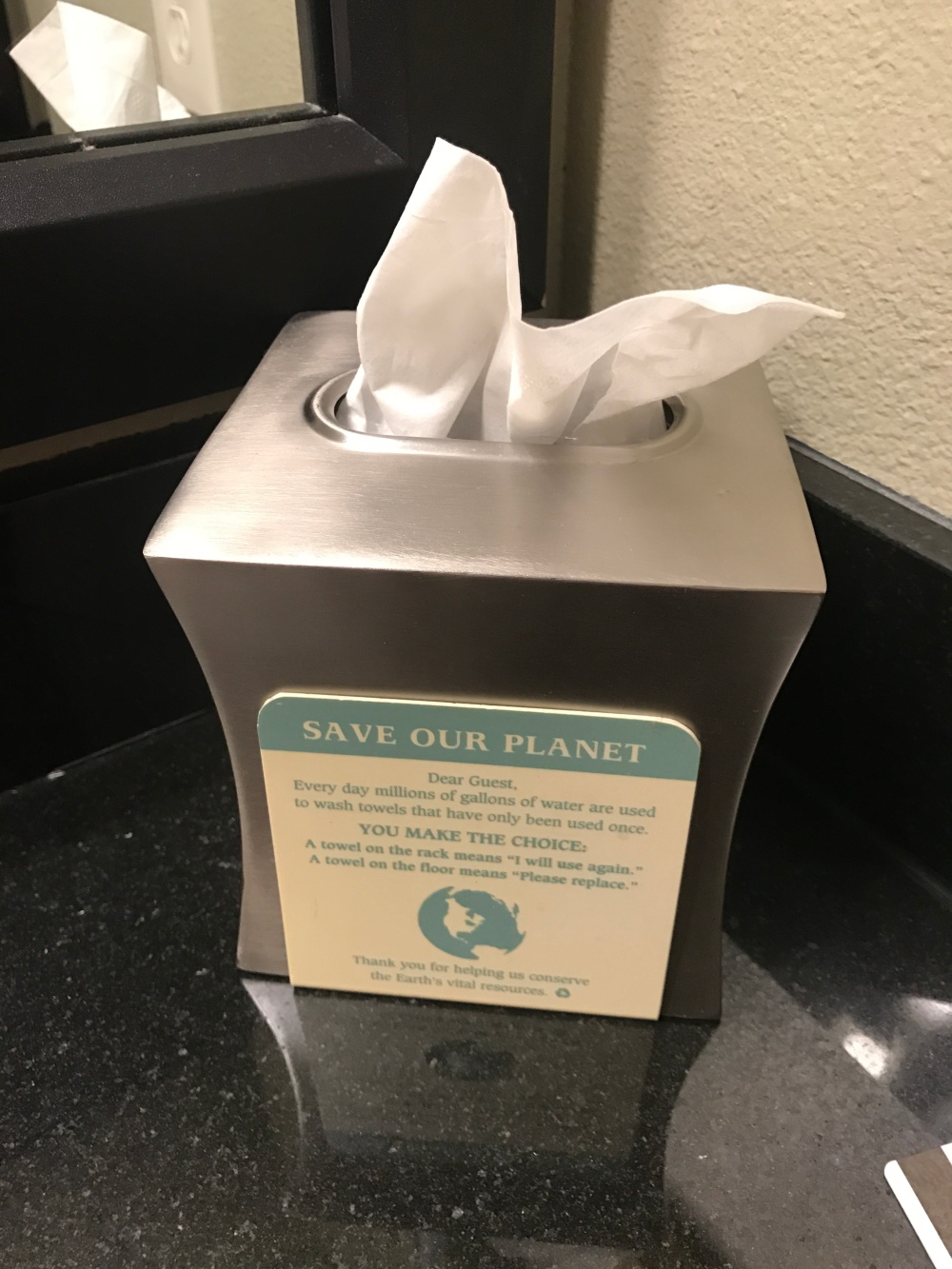
As with San Francisco and a few of the other parks, Zion encouraged you to use reusable water bottles, making use of the natural springs in the area to tap and deliver fresh water, reducing the need to buy and carry single-use bottles:
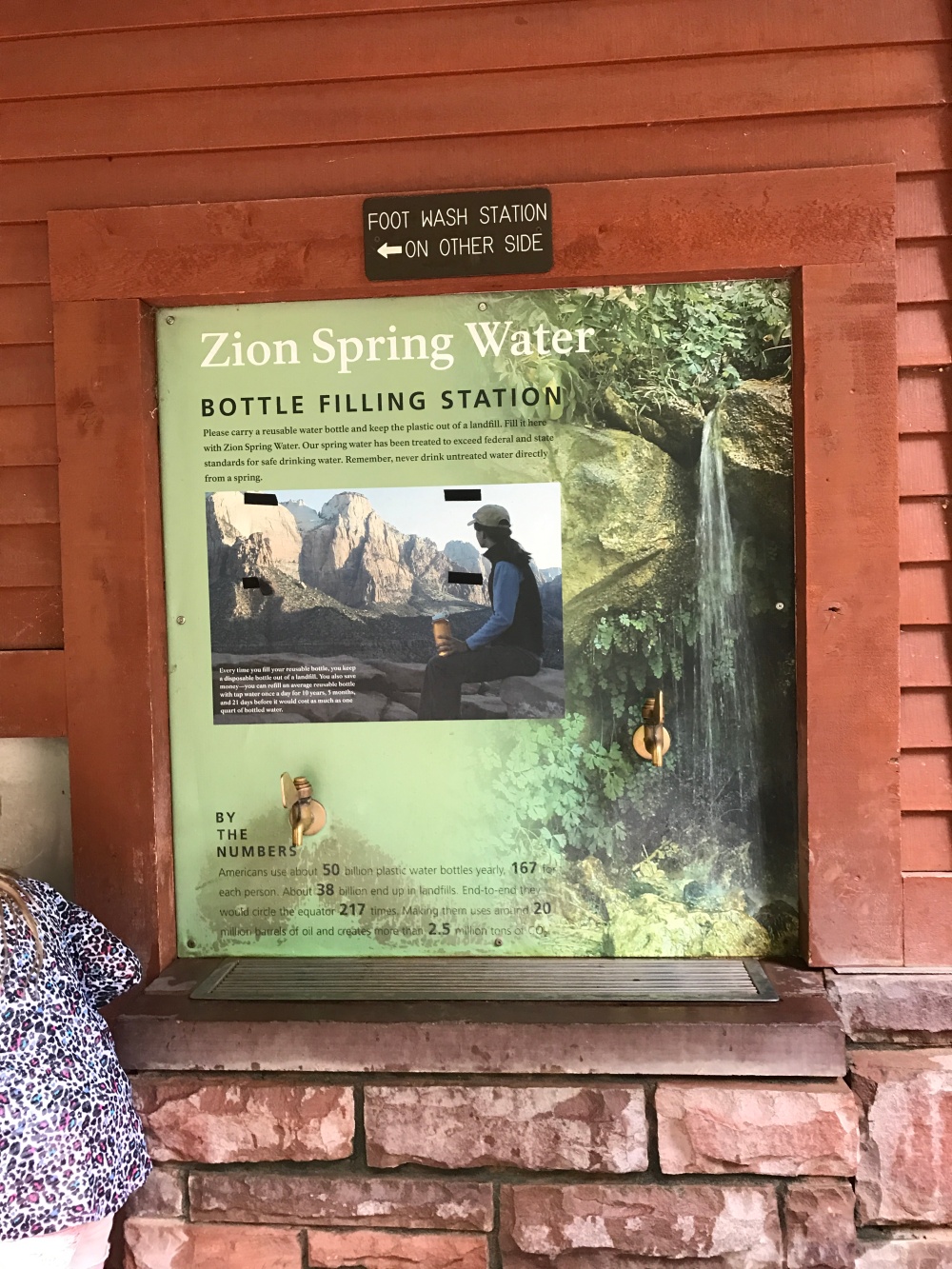
Bryce Canyon National Park UT
Fiery orange hoodoos piercing the sky creating the sharpest contrast of colour I have ever seen – Bryce Canyon was a wonder to visit and a real hidden gem.
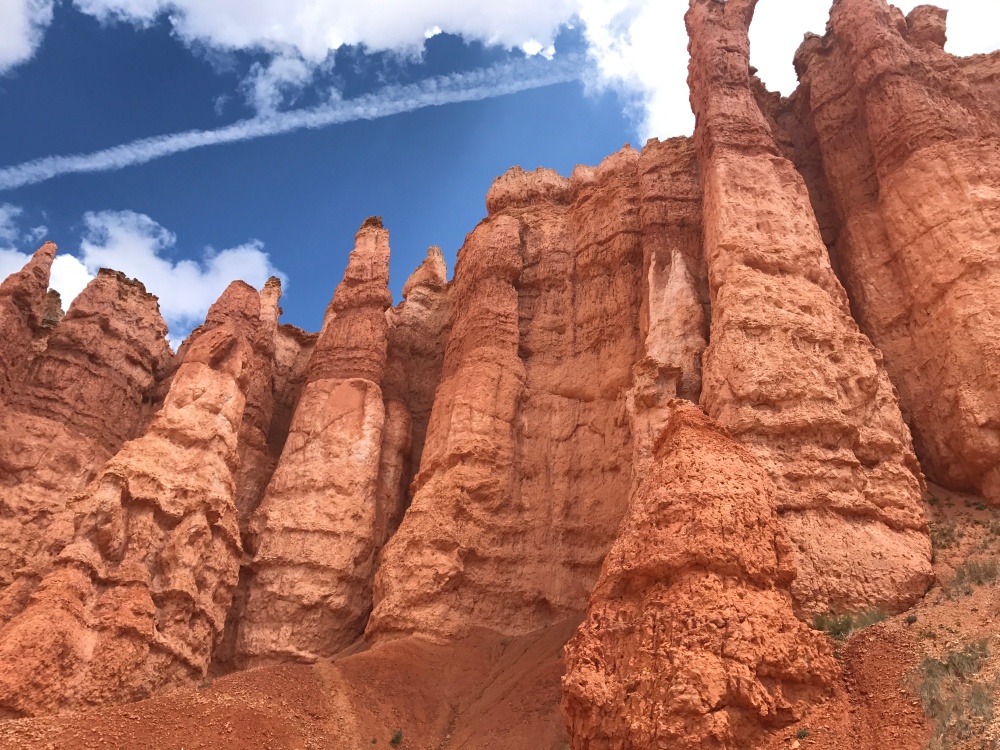

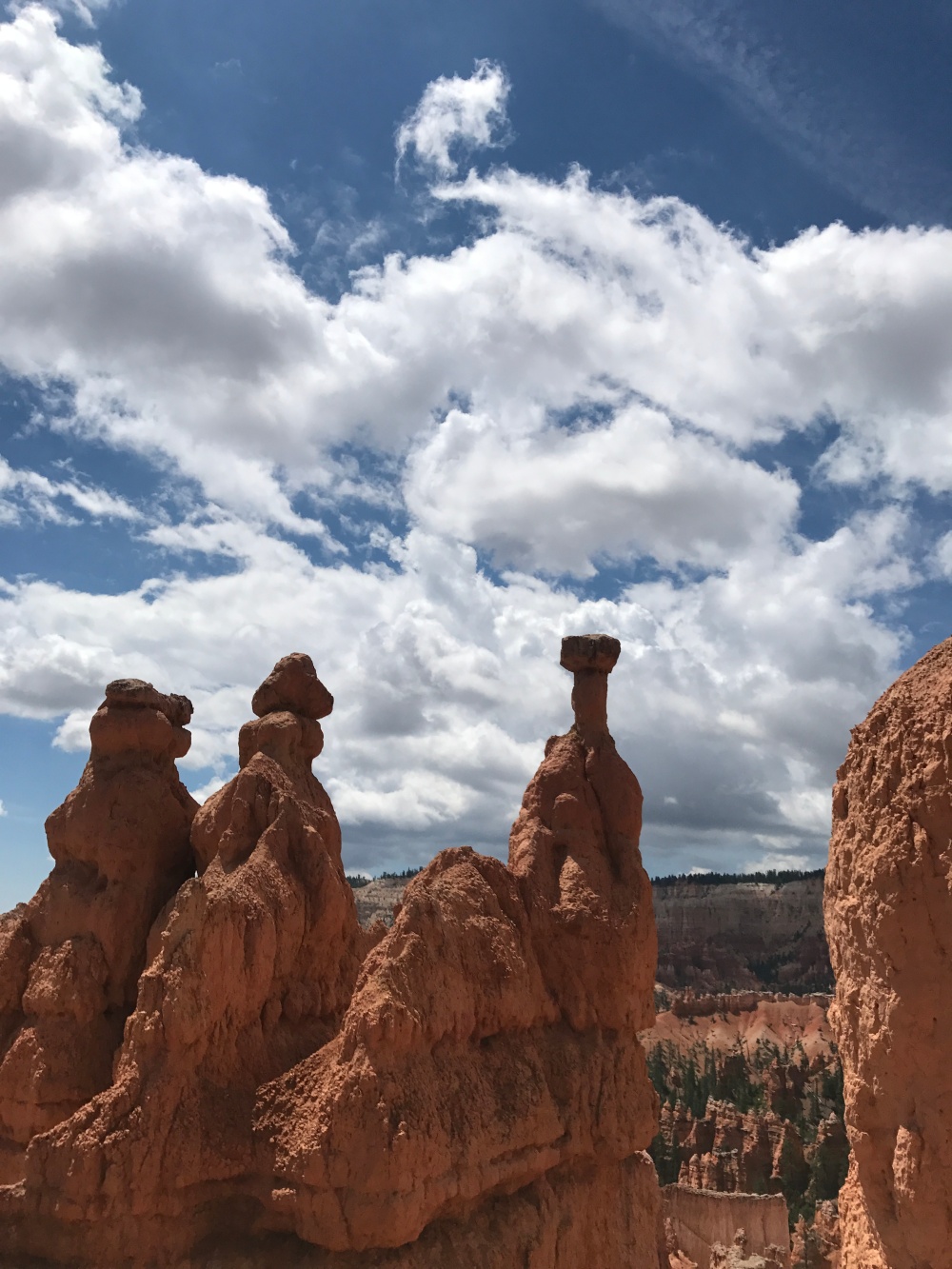


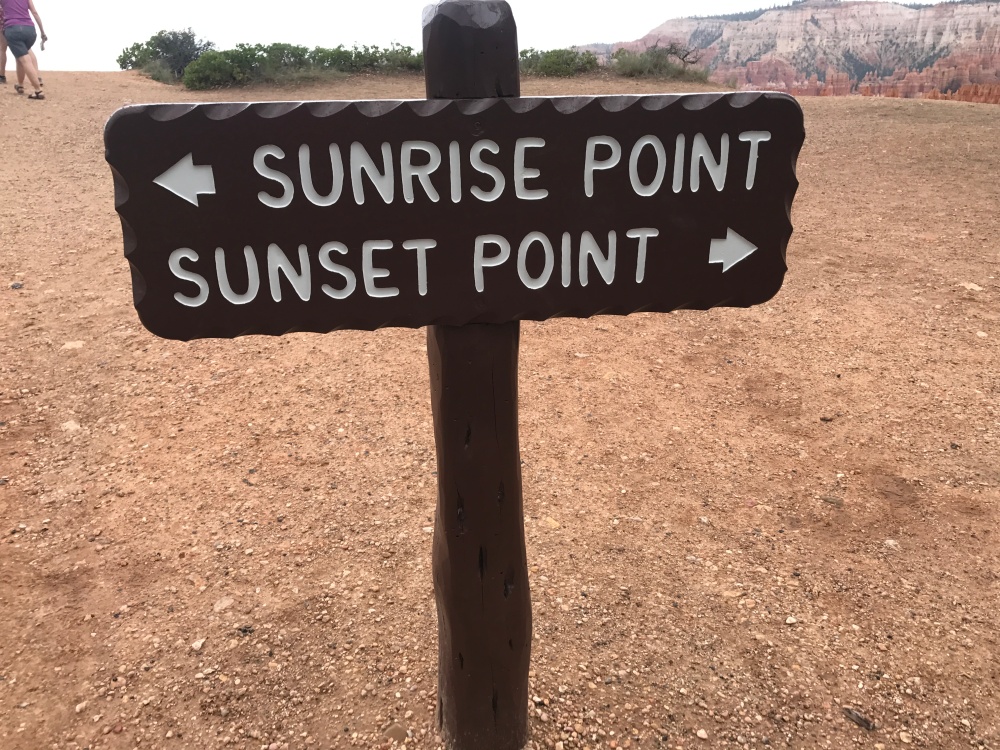


Like Zion, Bryce Canyon also had a shuttle system, and the park encouraged its use. As a result, the amount of land taken up by parking spaces and congestion were both reduced, keep the park air clean and preserving the remote back country feel which so effortlessly lures tourists and backpackers all year round.
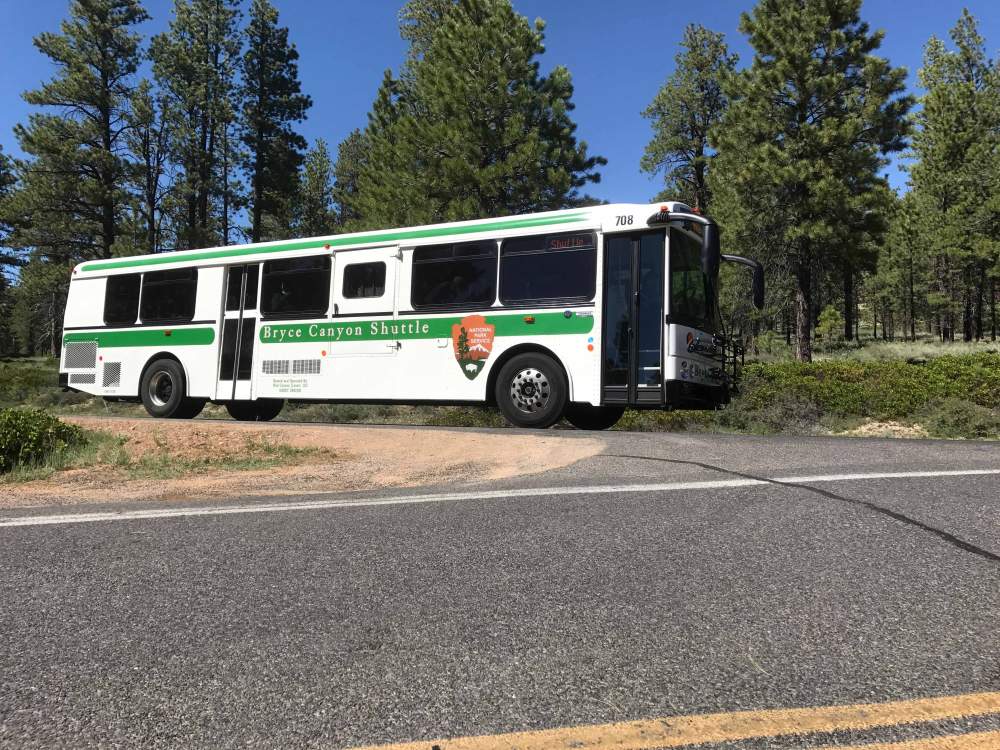
(source)
On the National Park Service (NPS) website I discovered that Bryce Canyon is part of the Northern Colorado Plateau Network (NCPN), an organisation overseeing the geology and ecology of 16 national parks in the surrounding area, including Bryce Canyon. Every year they produce an overview, detailing information gathered by a long-term monitoring program about the health of park resources. The NCPN state that some of the biggest threats to the park include trampling, invasive species, wild-stock grazing and adjacent land use activities. Their most recent brief details results from testing for aquatic contaminants industrial waste products and human/agricultural waste. In the test highlighted, they found significant levels of insecticide and the human hormone oestrone (estrone) which exceeded biological safety levels, and further tests will be conducted for persistent results. In my opinion, it is a wonderful thing that the NCPN are putting aspects of the park such as water bodies under such scrutiny. This further reinforces the idea that, when it comes to exhaustive human activity, remote areas and those qualifying for national protection such as the parks, are typically first to feel the effects, so studying them greatly aids our understanding of the impacts of our own activities.
Bryce Canyon is also home to extensive climate and air quality monitoring stations. In 1977 the park was designated a Class I air quality area, receiving the highest protection under the Clean Air Act. Although a recent report claims that parks like Bryce are just barely passing clean air assessments, due to factors outside of the park such as power plants, efforts within the park still prevail. Although air quality affects many other park features, such as vegetation and wildlife, visibility is the main aspect which is heavily reliant on the quality of the air. The stunning visibility of parks draws in tourists night and day and is affected when light is scattered by particles such as pollutants from plants and vehicles. Over the past quarter century the visibility has improved steadily on the clearer days, but worsened on the hazy days, according to the NPS.
In order to constantly monitor the air quality in the park, several stations exists to collect data on aerosols (particles suspended in the air) as well as the chemical composition of precipitation. The processes are described in detail here, but the park stresses that observing and maintaining the air quality within it is a complex and job. It involves not only physically monitoring the effects of air pollution on the park, but also preventative actions, such as educating tourists on the importance of clean air, and discussing greener energy strategies with businesses in the surrounding area to minimise the impacts of their actions.
Grand Canyon National Park AZ
Its grand.
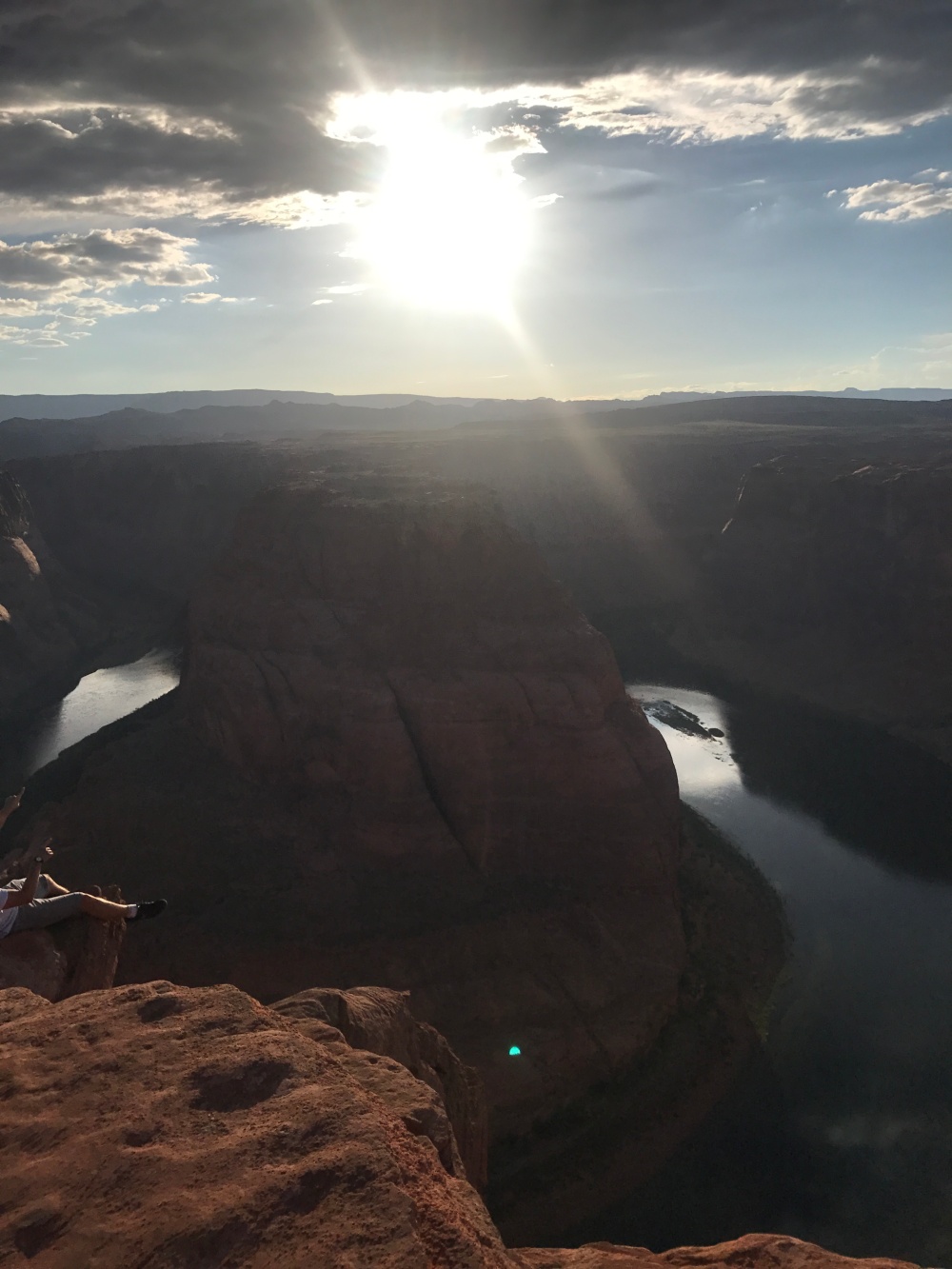



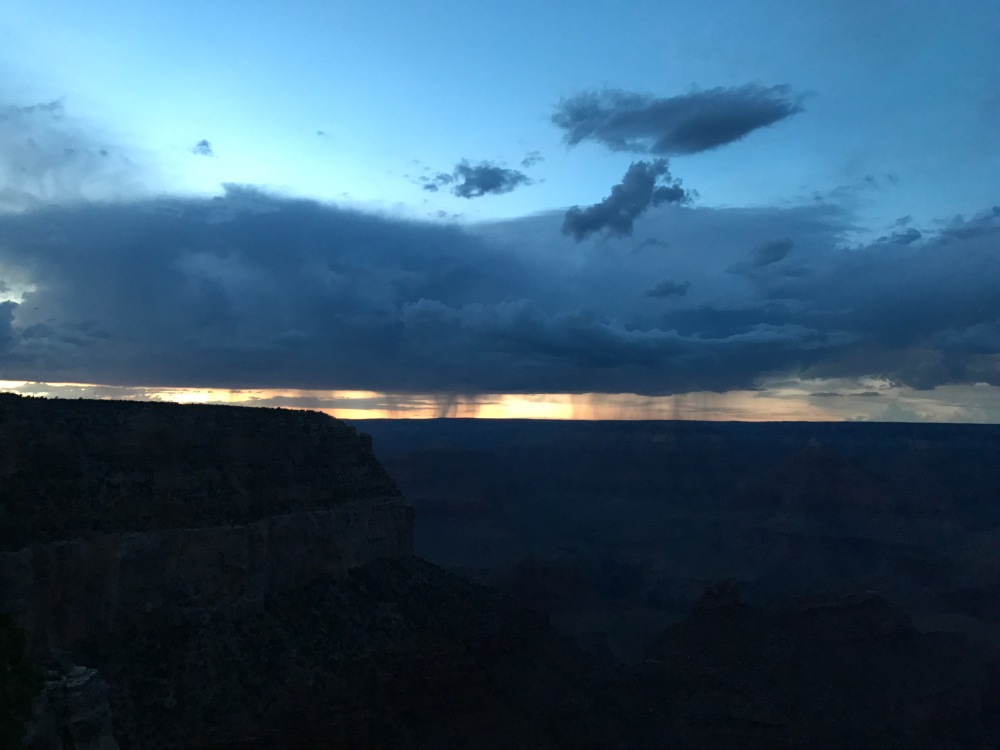
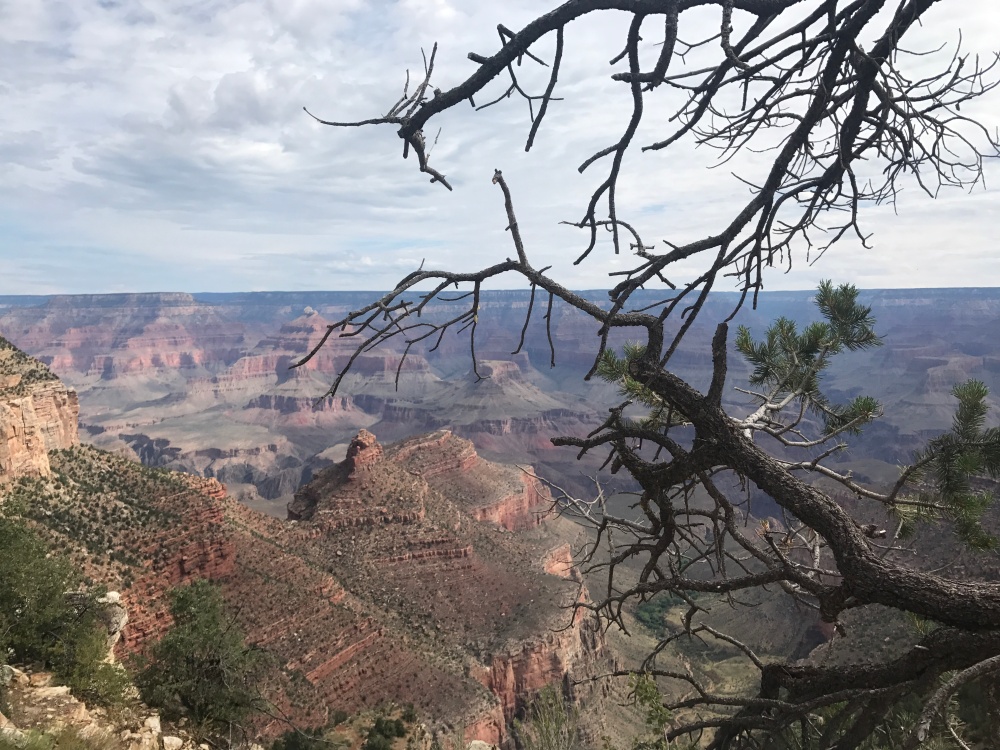

Grand Canyon National Park was the last one we went visited. This is a remarkable case study of the disappointing limitations of human perception, and it’s frustrating that we are unable to get a feel for its size all at once. For example, in photographs and even standing on the rim, the final decent down to the Colorado River appears little more than a small crevice, even though in reality it is several hundred meters wide and at least 600m deep in some areas. Alas, the park is a UNESCO World Heritage Site, and deserves respect, conservation and recognition.
We spent a full day hiking the Bright Angel Trail, a popular hiking trail with a central location. You can lose altitude quite quickly with a brisk pace, so sometimes its daunting to look up and see an 800m wall of rock above you, knowing that it holds the one way back to safety.
We hiked down a couple of checkpoints, and everywhere there were signs advising special caution for hikers in the summer, that hiking to the river and back in one day was highly NOT recommended (note: the grand canyon is GRAND), and to stay hydrated.
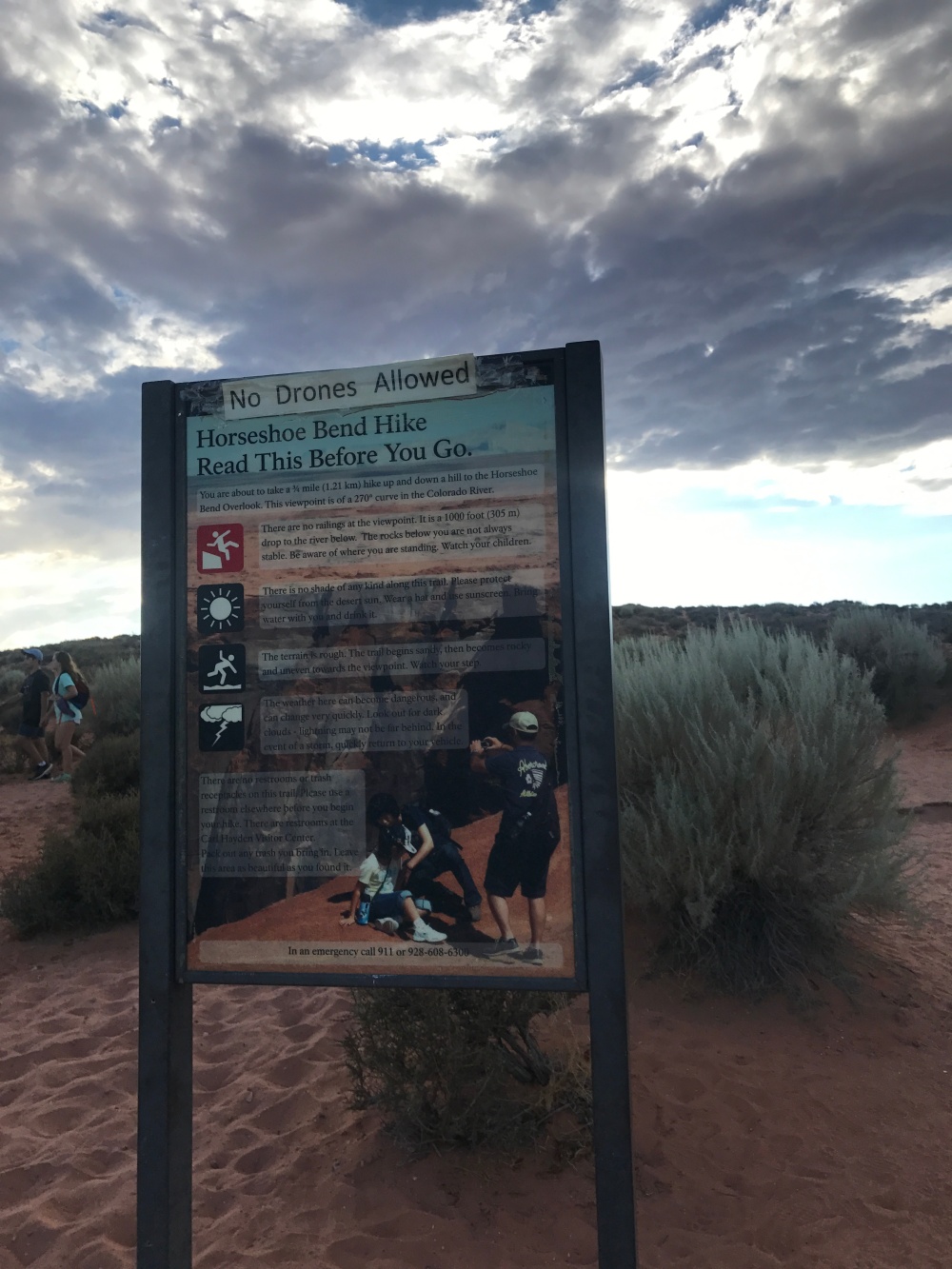
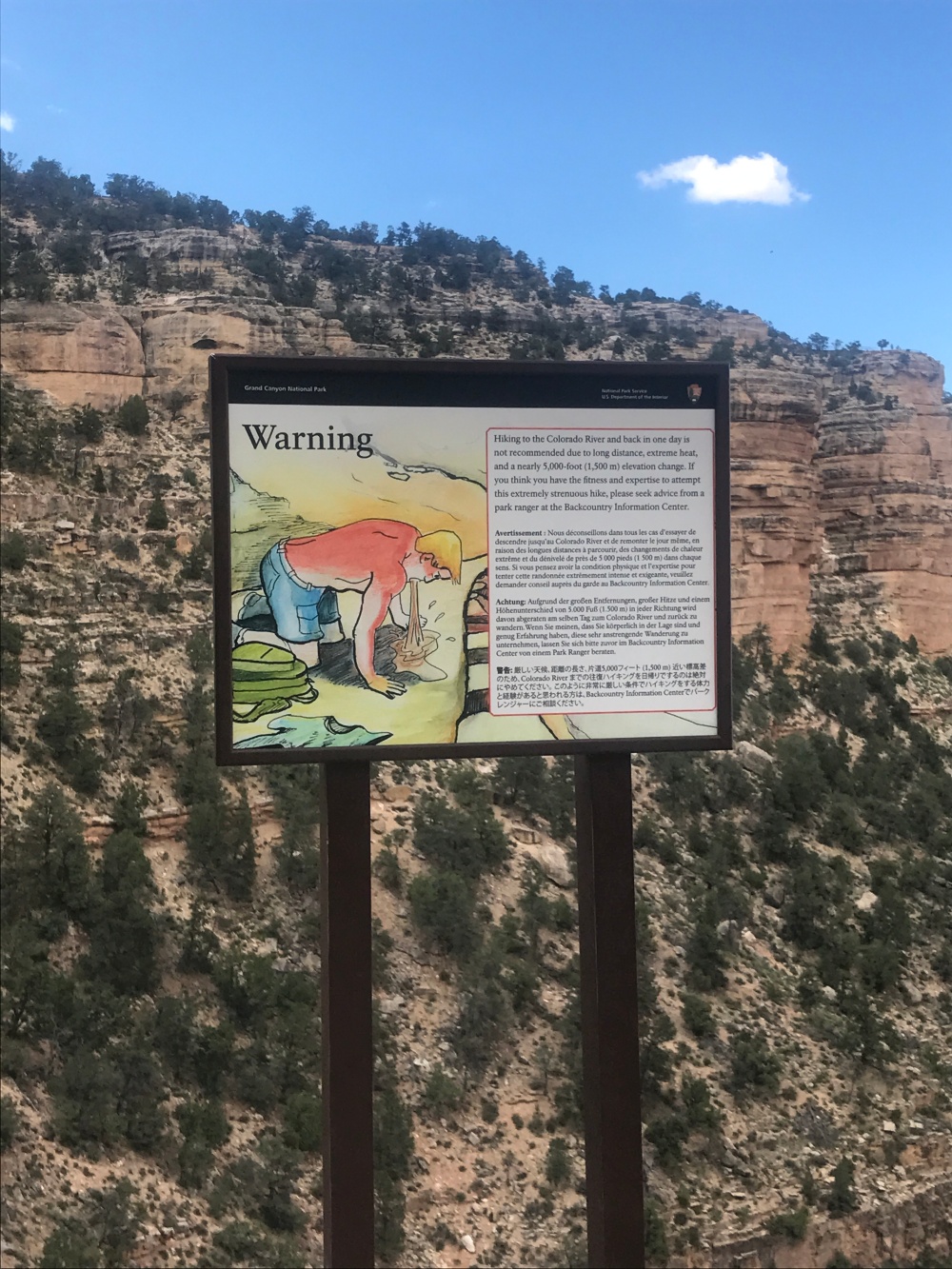
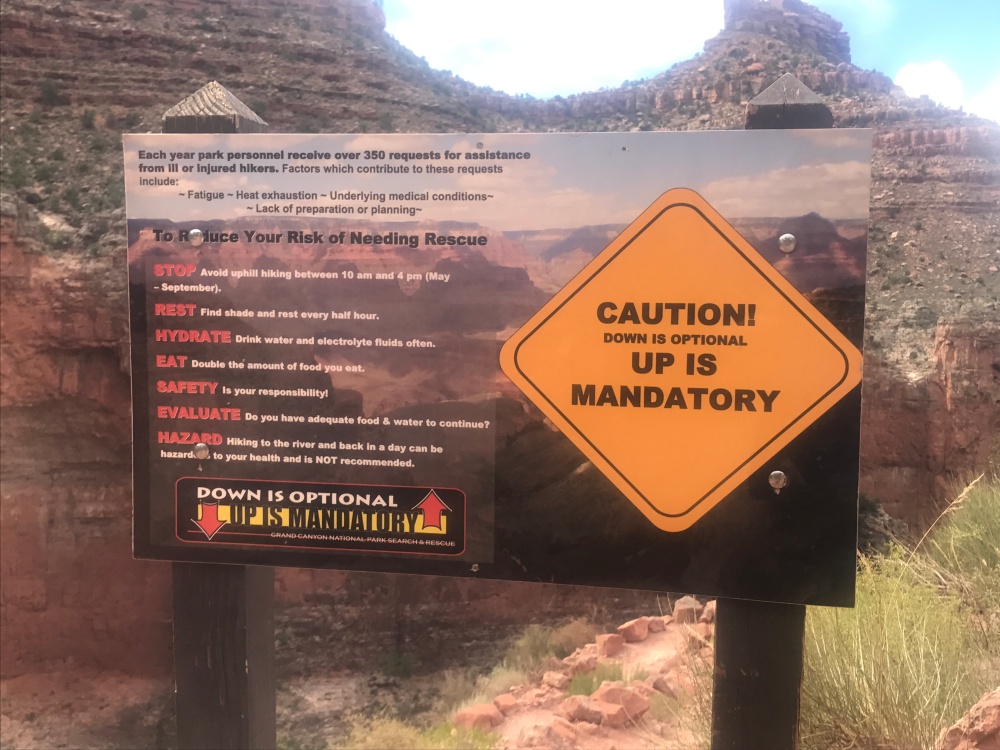
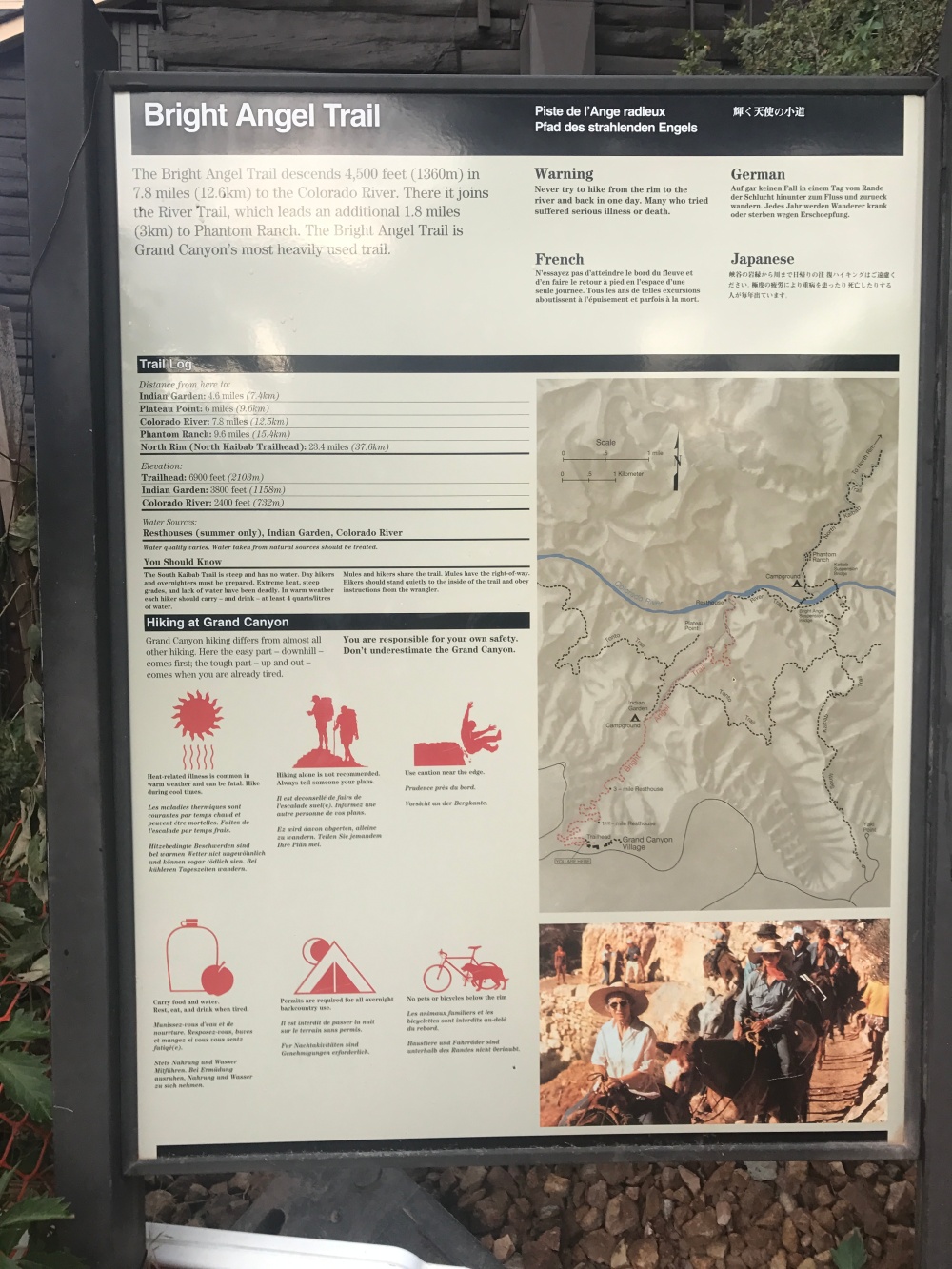
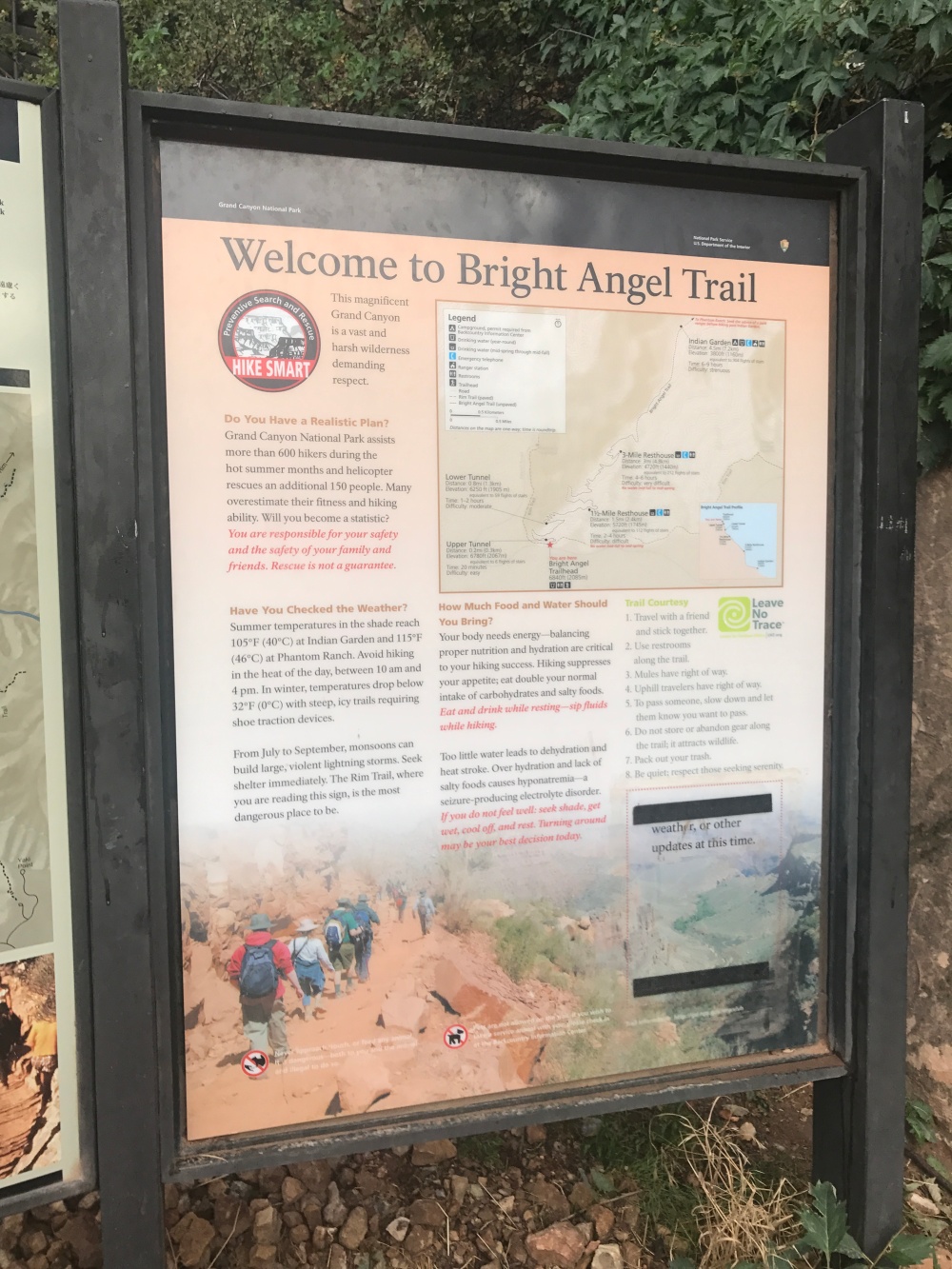
The accommodation that we stayed at, as well as the amenities at trailheads and other areas of the park stressed the importance of water conservation and limiting waste too. For this reason, not unlike at other parks, there were informative water bottle filling stations at (almost) every checkpoint on the Bright Angel trail, some operating all year round, that encouraged reusability. In the tourist-y part of the park, water was recycled and reclaimed for crop irrigation and toilets.
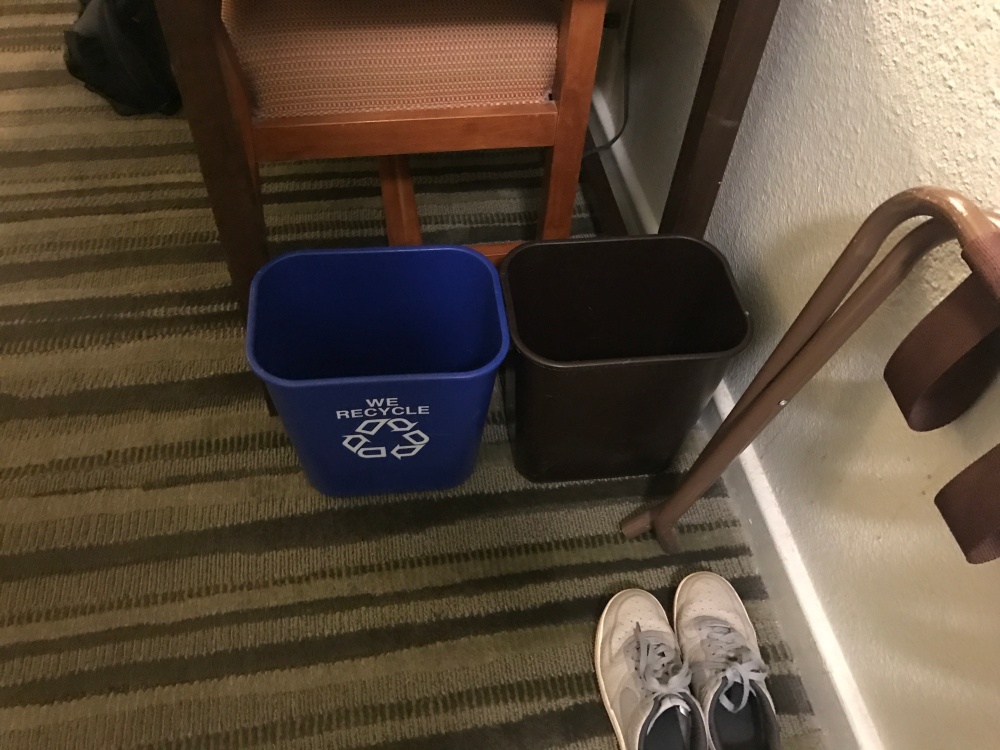
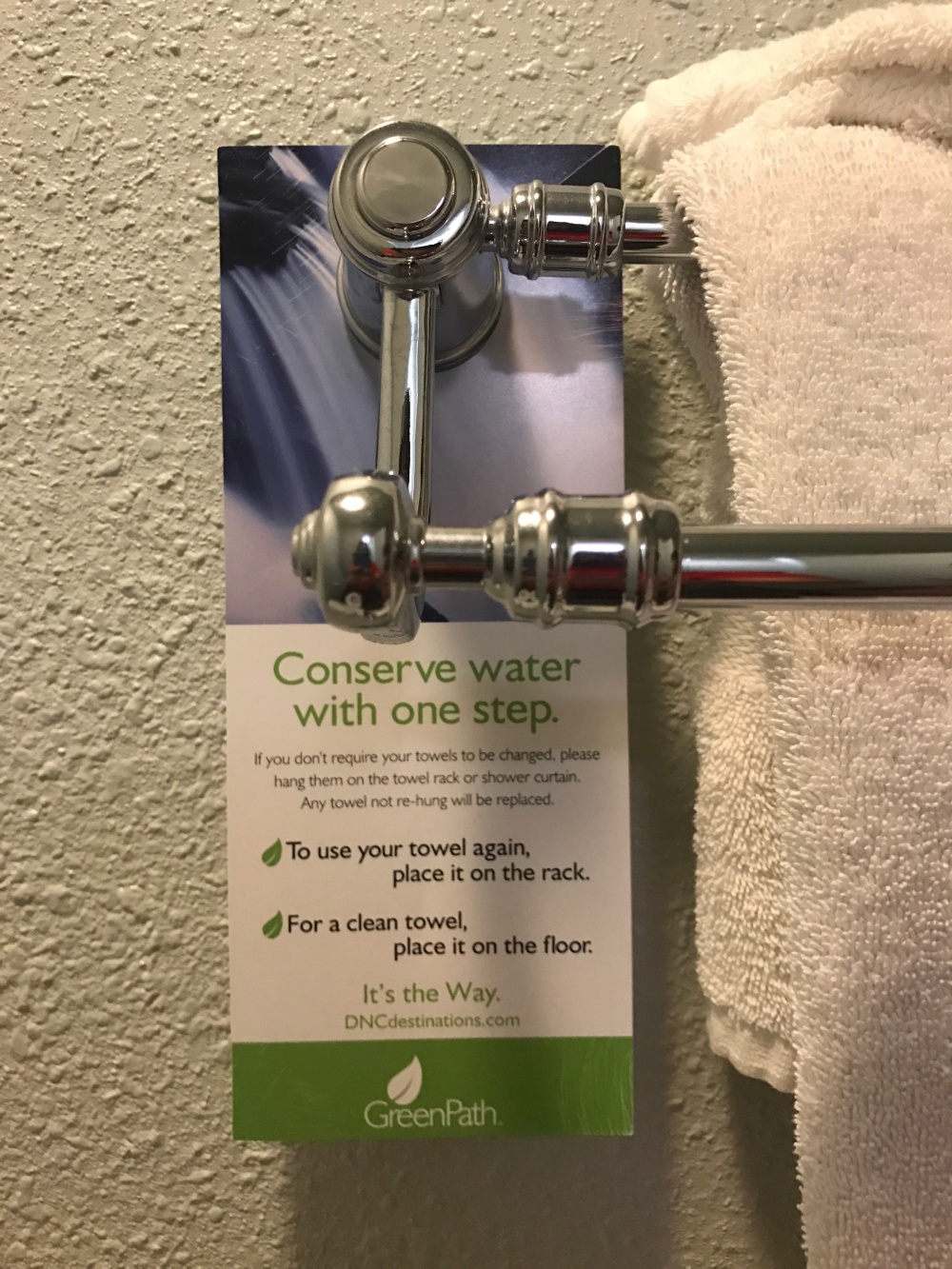
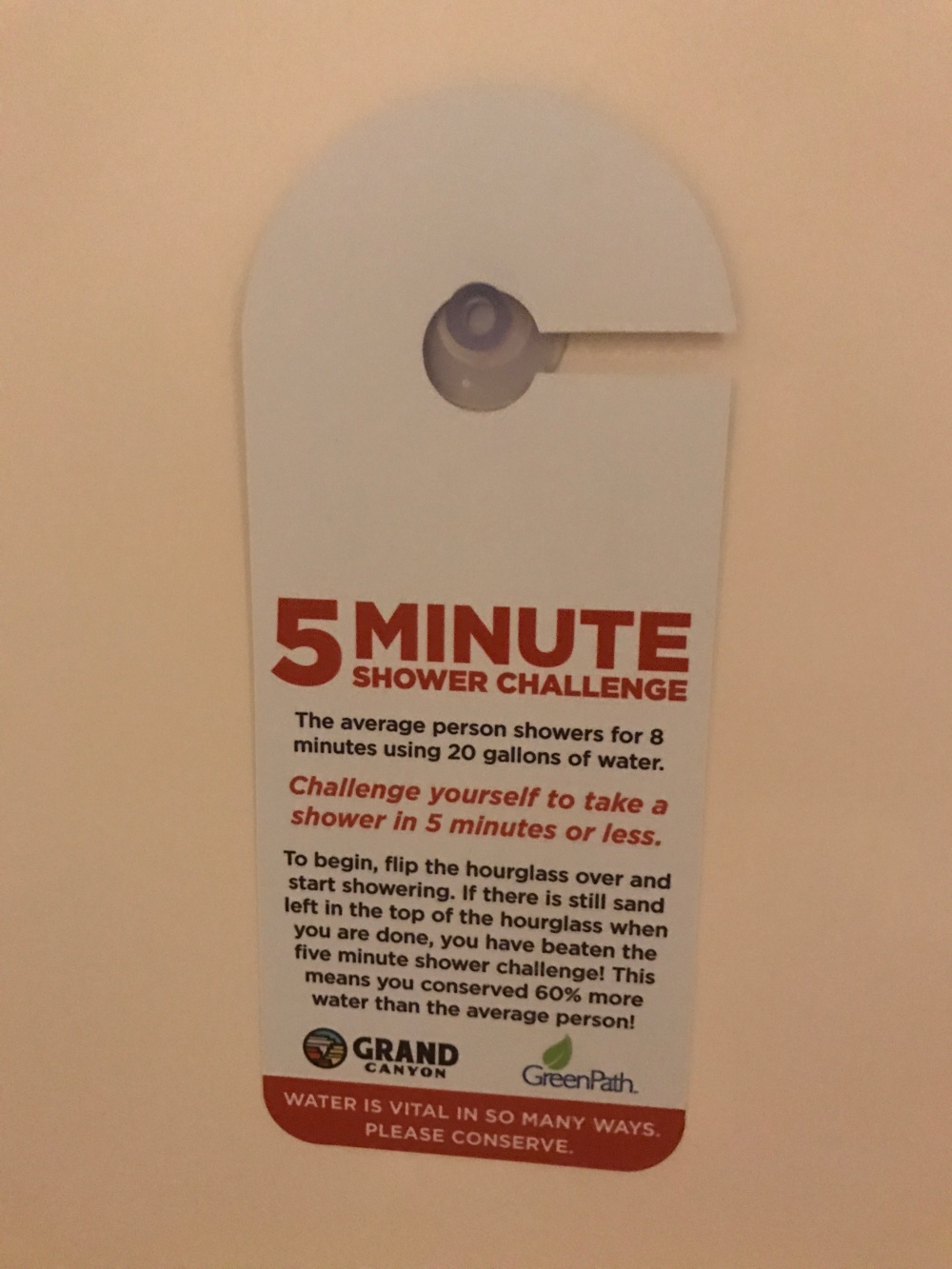
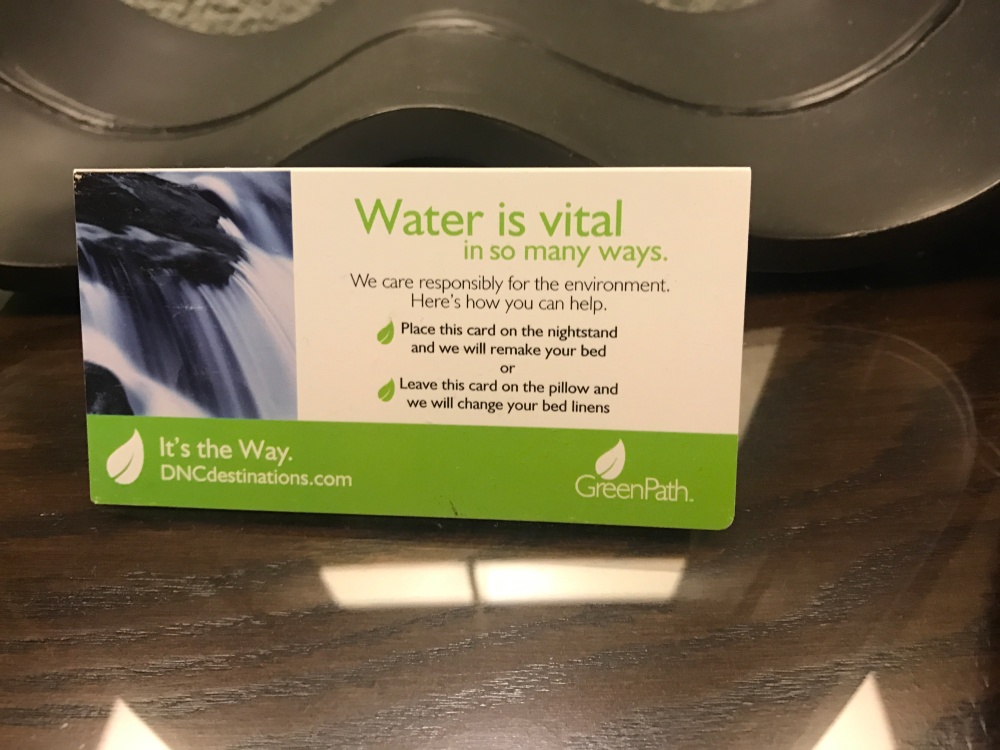
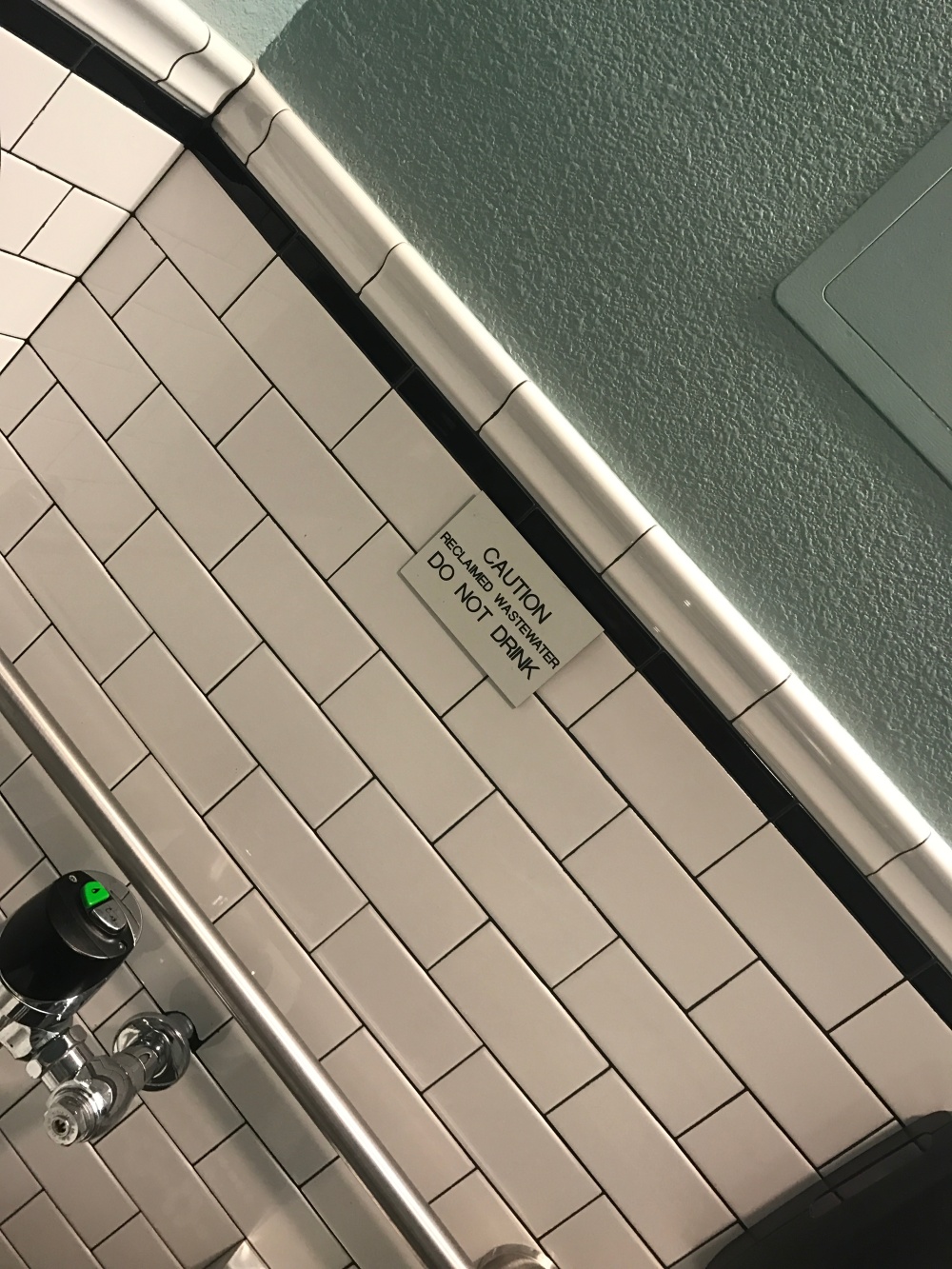

The National Park Service are aware that the park lies downwind of industrial plants and mining areas located in Mexico and California. These areas bring polluted air and reduce visibility at the Grand Canyon. The NPS are currently monitoring and evaluating the levels of toxins in the air, and are working with federal agencies and local organisations to reduce them. They are also actively trying to encourage visitors to use the environmentally friendly shuttle service instead of taking their own vehicles on some of the park’s busiest roads to reduce congestion.
When reading about other environmental factors, I came across something I had never considered before: wildfires being useful for the ecosystem and the dangers of suppressing them. Communities around the Grand Canyon in particular have gotten used to extinguishing natural wildfires, encouraging the build up of excess forest fuels which can lead to excessive ones. The NPS recognise that the benefits of wildfire are far-reaching, encouraging the prosperity of countless animal and plant species, and are invested in sustainable fire management methods.
The Park is committed to making its activities ‘greener’. They too have a detailed plan on their website, as conserving the park and its features is vital and reflects on the number of tourist visits, the ecosystems and the surrounding area. They have recycling systems in public areas, a water reclamation facility (mentioned above), a composting system and shuttles which run on ‘clean-burning’ gas. In 2010, the Grand Canyon became a Climate Friendly Park, with an action plan that aims to reduce all greenhouse gas (GHG) emissions by 30% by 2020.
Dam.
Not the Hoover Dam, but still a dam. The Glen Canyon Dam to be precise and it looks even better in google maps (satellite mode). 220m high, its size is once again too grand to fully be captured by a phone camera. It dams Lake Powell and is a vital source of hydroelectricity, generating 4 billion kilowatt-hours per year. Although it provides electricity for around 5 million people in 6 surrounding states, offsetting three billion kilograms of carbon dioxide emission per year, it is somewhat controversial, with reports of huge evaporative losses at Lake Powell and wide scale ecological damage downstream in the Grand Canyon itself.
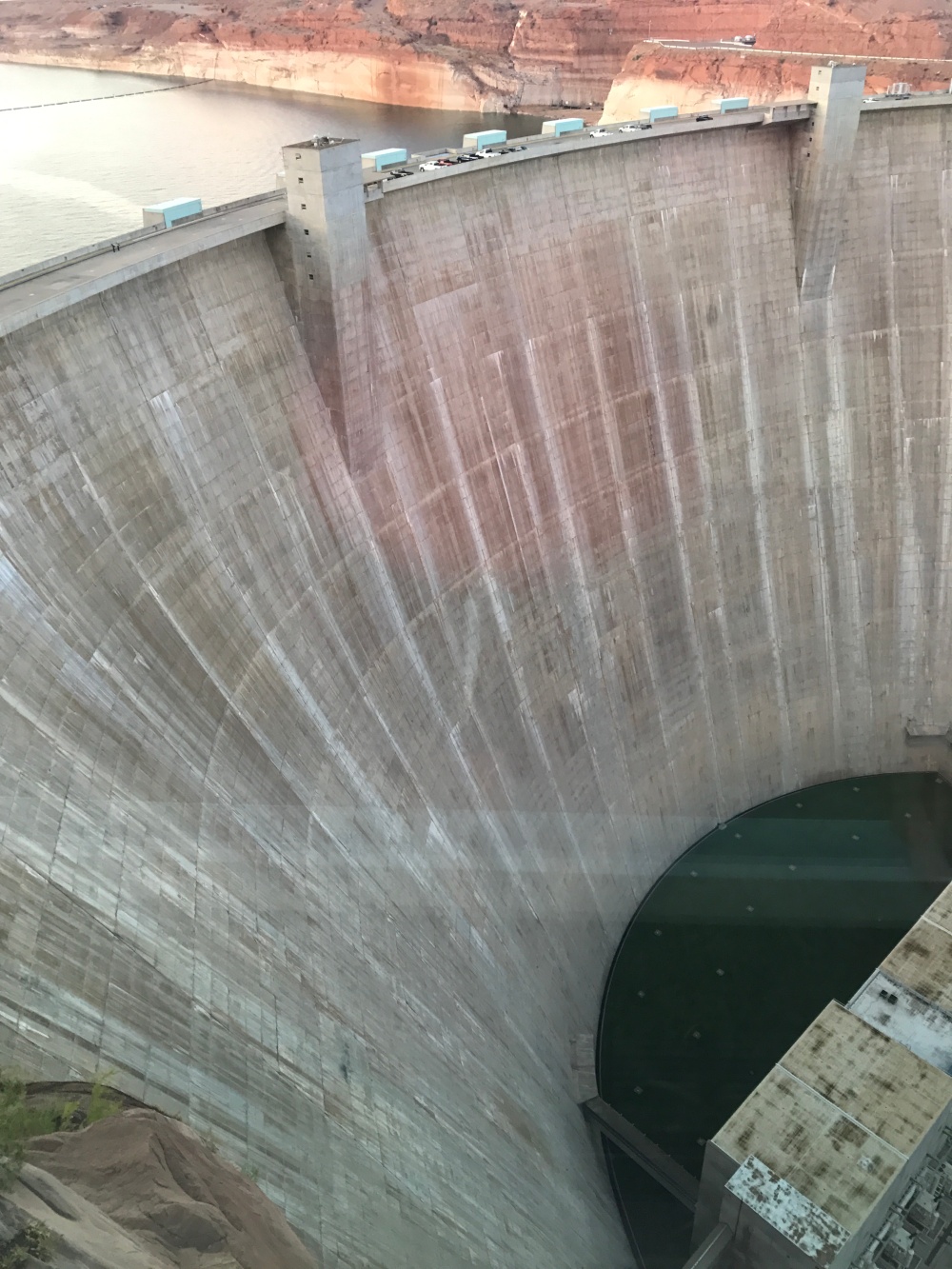
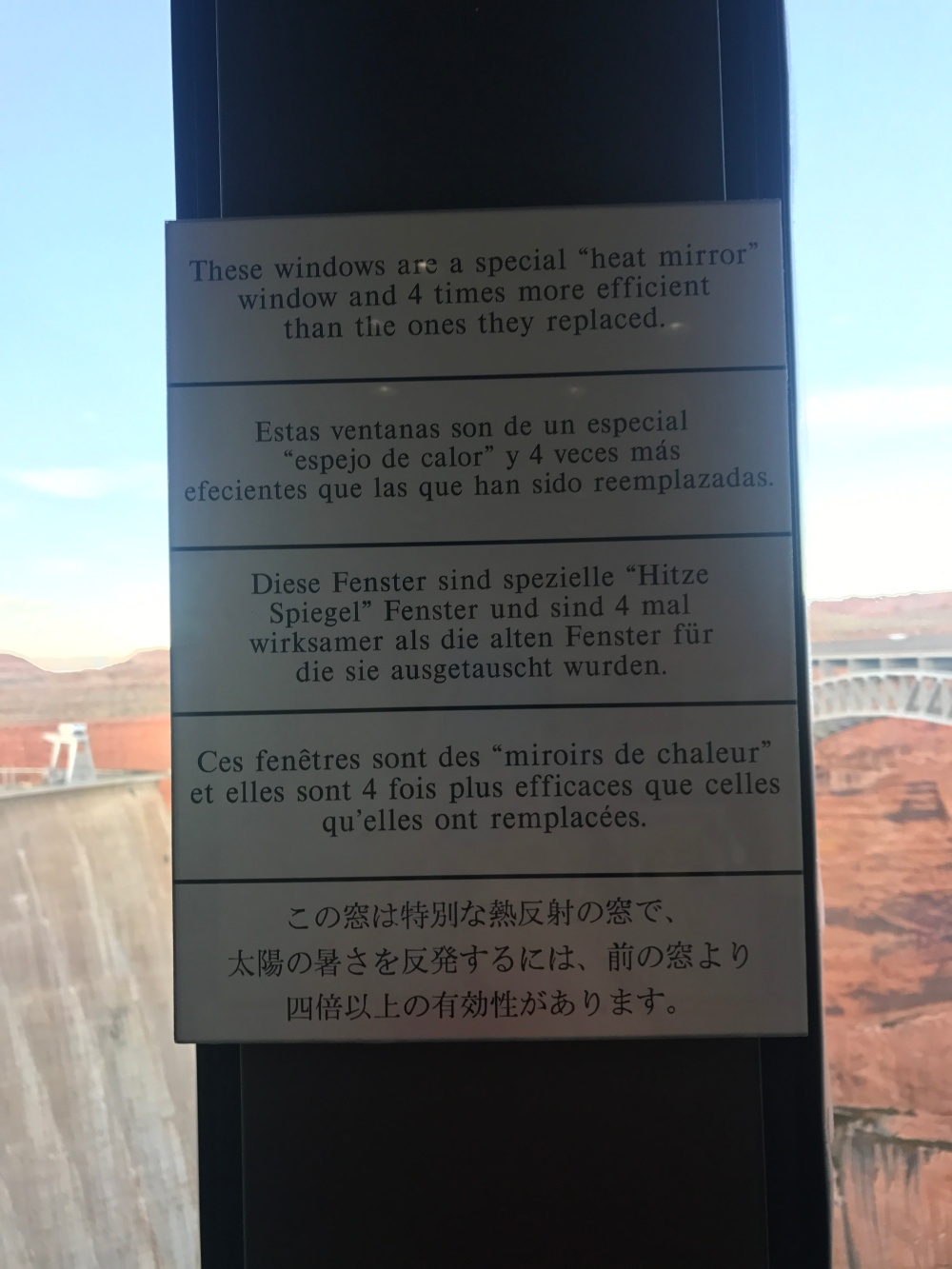
Panoramic windows at the Carl Hayden Visitor Centre, primary tourist information point for those seeking entrance to the Grand Canyon National Park and Horseshoe Bend at Page.
Las Vegas
The City of Sin, our last stopping point, was a very different beast…somewhat disappointed me. Gone were recycling bins and signs telling us to conserve water. Any methods of conservation were obviously tucked out of sight, as observed by Sierra Club’s Nevada director, Lydia Ball. Las Vegas is in the middle of a desert, yet somehow it made sense that they did little in the way of acknowledging the lack of resources in such a location. It is a city that is evidently all about luxury and consumerism. The very notion of ‘Vegas for the Weekend’ is rooted in the desire to get away from the pressures of every day life: to indulge and relax…and to play blackjack. Certainly on this kind of vacation, everyone expects that the last thing a person wants to hear is to take a 5 minute shower.
Vegas screams luxury, from buffets to brunches, imitations of World Heritage Sites and high-end boutiques, it is in itself a profitable business, in fact (albeit in a different context), it was reported that green-energy mandates actually hold back such economic prosperity. This consumerist culture is unlikely to end, it is undeniably surplus and tourists visiting either truly don’t care or don’t understand its impacts.
There are some signs that resorts and casinos in Vegas have taken action to go eco-friendly, all hidden within the blueprints and paperwork in the form of solar panels and LEED-certified buildings.
An interesting thing that I read was this quote from the spokesperson of MGM Mirage, a mega business in Vegas owning several multi-billion dollar resorts and casinos:
“Keep in mind that we are in the resort-hotel business, and the people come to stay with us to have a four-diamond experience, as practical as they are, sometimes the big blue bin just doesn’t fit in with the décor. We do recycle, but we don’t need to ask our guests to do the work for us.” – Gordon Ashber, MGM Mirage
Interesting, so anything less than a four-diamond experience implies that you as the guest have to ‘do the work’? Does that mean personal environmental responsibility is reserved for three-diamond experiences? Two-diamond? For ranches and motels? For the less luxurious? More importantly, does that mean that if you pay a slightly higher price you have automatically sold your own responsibility to monitor and reduce your carbon footprint? How can you be sure that the management you are paying for is doing all they can in the name of conservation behind close doors?
It’s a trivial problem… it appears now that money cannot buy you happiness, but it can buy you out of taking a split second to decide whether your empty plastic bottle goes into the black bin or the blue one. Is this what luxury is all about?
(Kind of) miscellaneous
Throughout our road trip, I saw many other signs, and campaigns making an effort to be sustainable.
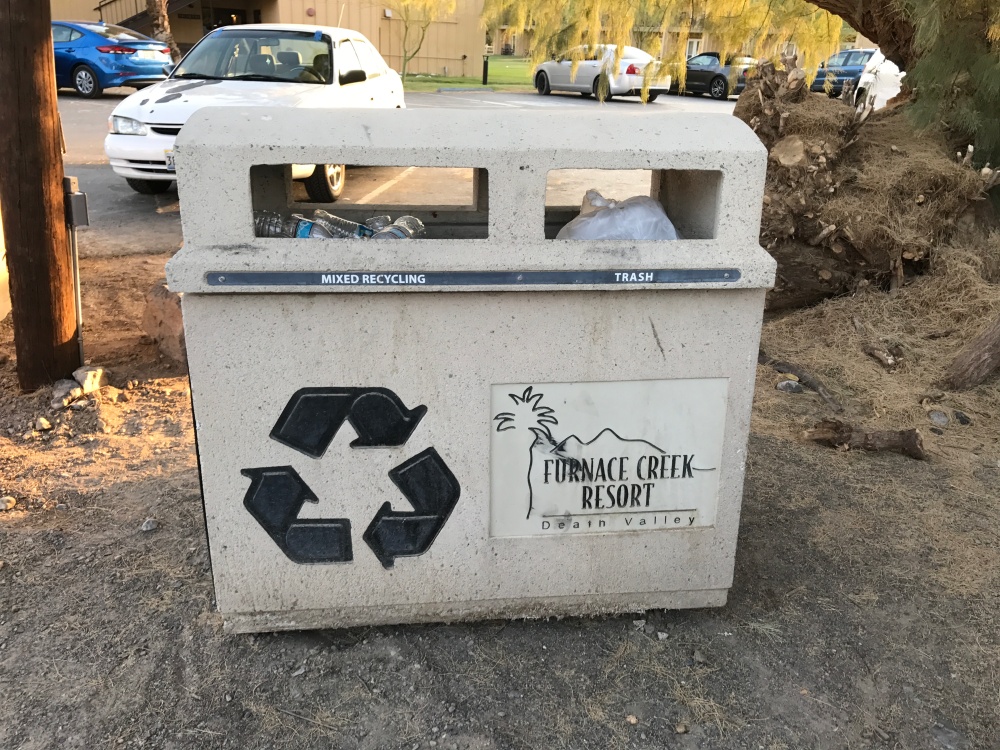
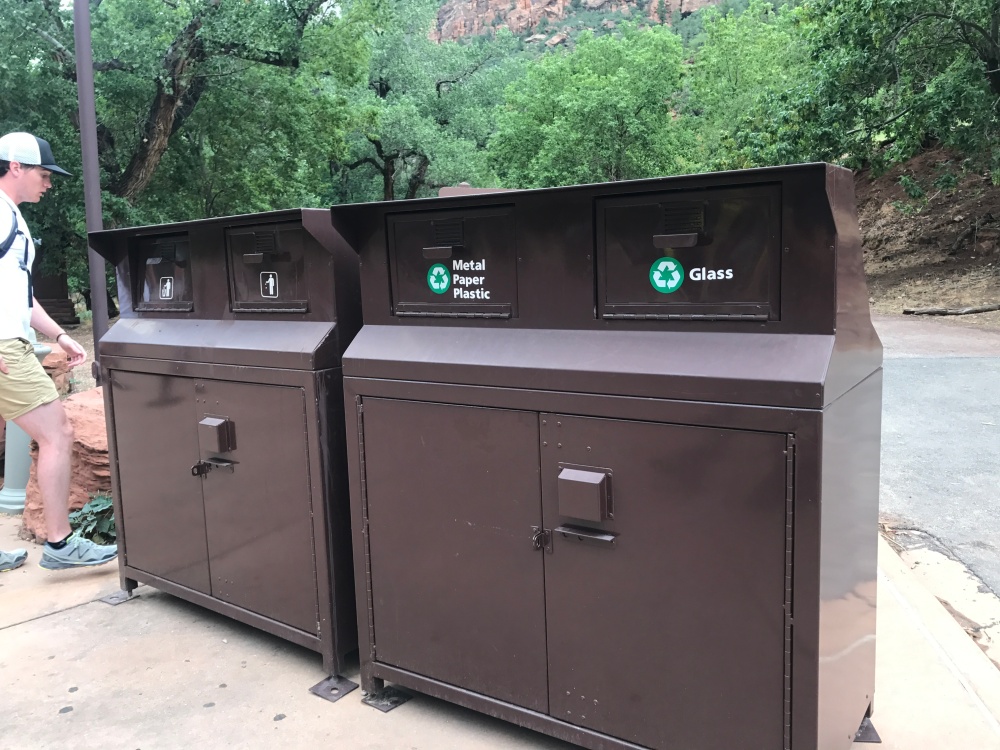
So many bins. Everywhere. Almost every outdoor bin I saw was actually two bins like this one: with both a mixed recycling and a trash section. This kind of initiative encourages people to think twice about what they are throwing away, what it’s made of, and where it will end up. Over time, I’m sure that these subtle signs develop into a much greater conscience about the nature of waste and recycling, and leads people to make more eco-friendly decisions about the things that they buy and use.
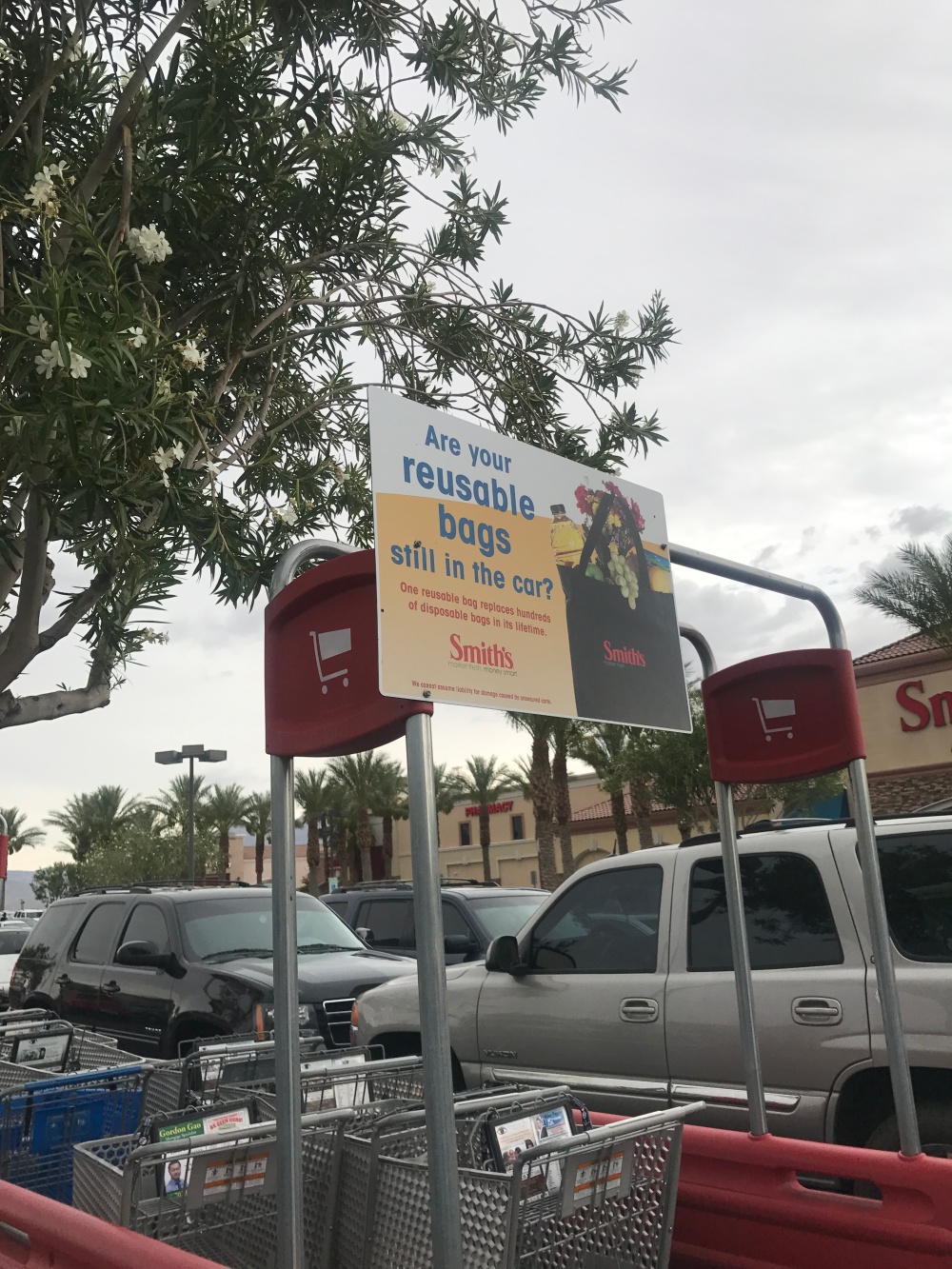
Verdict
Overall, I came away from the trip very impressed at somewhat as peace. I had expected minimal effort in the way of sustainability from the greatest energy consumer in the world, and I was met with enough counter evidence to reinforce my opinion that not all hope was lost. That been said, while all of this is great, the enormous consumerist culture, evident from places such as Las Vegas, needs to be addressed. We cannot continue damming lakes, putting up recycling bins, fitting solar panels, and building moderately expensive electric cars if the energy and resources used in mass producing them in the first place continue as it is and cancels out the effects of going green, putting them in negative. As Mark Vitter, a USA TODAY commenter put it: “You think Vegas, you just think of this huge international symbol of waste […] its very existence is almost a crime against nature. No amount of conservation can replace what ought not be used in the first place.”
Sustainable living needs to be revolutionary and accessible for all socioeconomic classes. It is no good if only those with a high income can afford to buy organic food and drive electric cars if they do not even represent the entire population to begin with. It is no good ignoring the growing gap between the rich and poor, and capitalising on the limited choices in nourishment and lifestyle brought upon people by circumstances beyond their control.
I was immensely relieved that, with a little more development, the plans and projects I saw (especially in cities) could potentially lead to game-changing policies which create permanently eco-friendly and sustainable areas in the US. However, at the moment, it is the disposable, instant-gratification culture which scares me the most. If we want to demand the right to live in this way we must find such an approach which stables our enormous energy output. A culture where fast-food, petrol cars and unlimited electricity is seemingly at our fingertips is a double-edged sword. While it is a remarkable turn of the times to have so many amenities so easily available we must take responsibility in the way that we consume the resources that we have. Whether that is possible in the near future, or the product of a million determined and dedicated projects, efforts and activities such as the ones I had the privilege of seeing and documenting, we must all collectively recognise the urgency of this matter, and start acting now.
All photos, unless otherwise credited, are my own.